 US Navy (1918-47) – Converted fleet carriers: USS Saratoga, Lexington
US Navy (1918-47) – Converted fleet carriers: USS Saratoga, LexingtonWW2 US Carriers:
USS Langley | Lexington class | Akron class (airships) | USS Ranger | Yorktown class | USS Wasp | Long Island class CVEs | Bogue class CVE | Independence class CVLs | Essex class CVs | Sangamon class CVEs | Casablanca class CVEs | Commencement Bay class CVEs | Midway class CVAs | Saipan classThe Lexington class aircraft carriers: Return on the largest warships of their time, first USN fleet carriers, only one to feature a 80-aircraft group. They were born almost by accident, converted from the impressive Constellation class Battlecruisers projected in 1916 and built from 1917. The two most complete ship when the Washington treaty forbade them, appeared to be USS Lexington and Saratoga. In 1922 it was decided to convert them into the country’s first fleet carriers over five years, as they were commissioned in 1928. They saw virtually all generation of carrier aircraft in service until USS Saratoga, surviving her sister lost at the Coral sea, ended in the atomic test Baker in 1946.
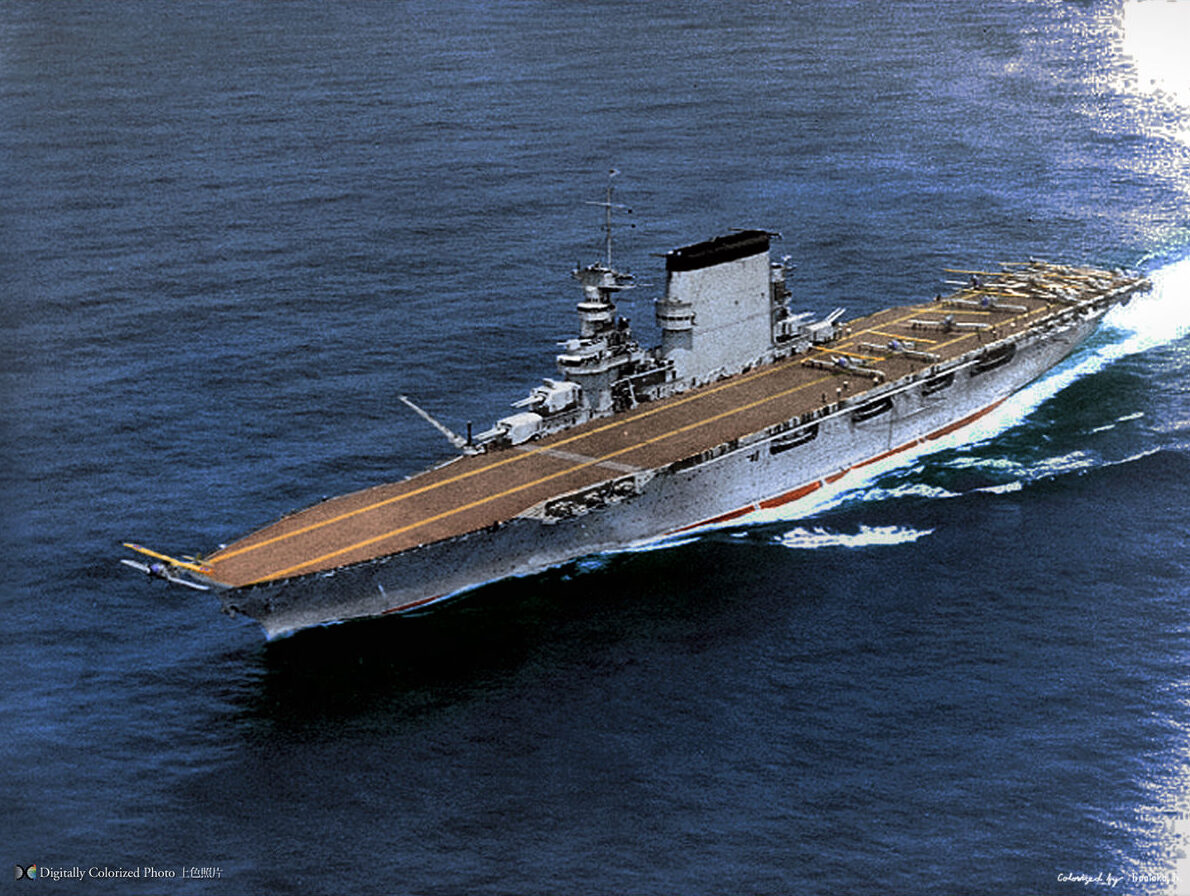
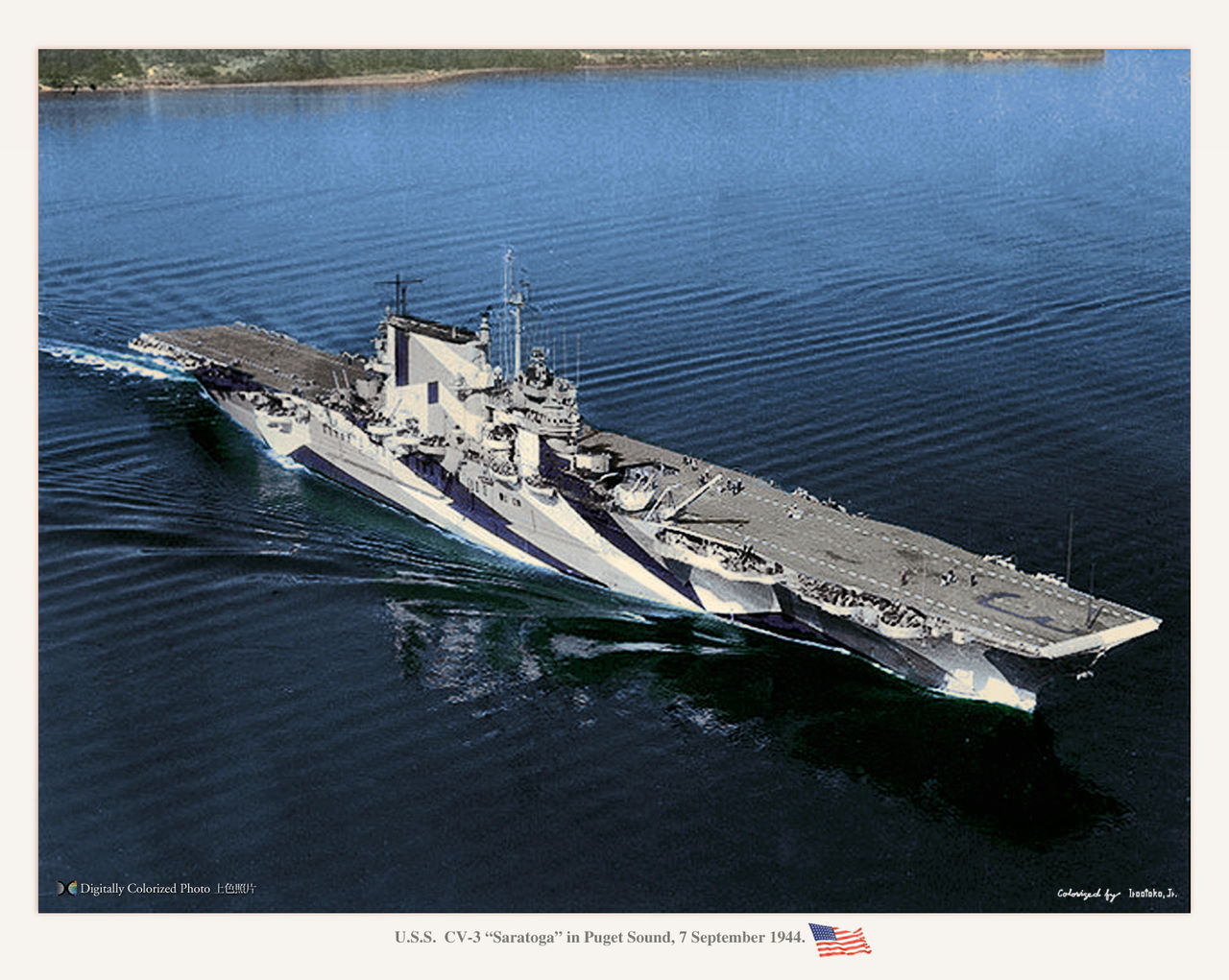
The two USN most splendid Ladies as colorized by Irootoko Jr.
They were the product of their time, with both many in the admiralty and the bureau of construction and repair having serious doubts about the capacity of her air group to defend her, required the installation of a heavy cruiser armament completed by a dozen 5 inches AA guns. They were unmistakable by their massive bridge-tripod and funnel in addition to these turrets and the fast carrier ever built at 35+ knots for a range of nearly 12,000 nautical miles thanks to their humongus 130,000 hp powerplant relying on electric drive. They were also as pivotal as the Yorktown class fr the Pacific campaign, soldiering and being badly damaged (Saratoga also nearly sank) in the crucial year of 1942. Rewrite and expansion of the old 2016 post, 8 years ago… It was time !
https://naval-encyclopedia.com/ww2/us/lexington-class-aircraft-carriers.php #ww2 #usnavy #unitedstatesnavy #lexington #saratoga #pacificwar #coralseabattle #santacruzbattle #leytebattle
A lasting footprint: The Lexington and Saratoga were the first US aircraft carriers and left a lasting imprint on the history of the Navy. From 1928 to 1941, these ships formed generations of pilots and flight officers who initiated the long tradition of American naval aviation. Affectionately these “old ladies” had been nicknamed “Lady lex” and “Lady sara” in the fleet. Their unmistakable slender figure and huge funnel, cruiser artillery, slender bow and greyhound performance, surpassing all that the US Navy could offer at the time, became legendary.

USS Saratoga underway circa in 1942
The first and last American Battlecruisers
Battle cruisers: The genesis of these ships went back to the entry of the US into WWI by April 1917. Indeed, the ship was ordered on plans in 1916 as battle cruisers, in the wake of the arms race initiated before the great war. During that time, construction was postponed and suspended to give priority to destroyers, then resumed before being stopped again, this time by the Treaty of Washington in 1921. The latter limited for the US and five major naval powers both tonnage and gun caliber. This prohibited the construction of any ship of line for ten years.
Note: A dedicated article will be made on the Constitution class battlecruisers.

As a result, the Lexington class, initially planned as six 42,000-tonnes standard, 874 ft (266.4 m) overall (266-meter) long, eight eighteen inches (457-mm) main guns vessels. They were already well underway in 1922, until suspended, pending a decision by the Admiralty. Since the treaty considered aircraft carriers to be essentially reconnaissance auxiliaries, mostly for defense and not attack, no limitation was imposed on them. Thus gave the admiralty some leeway in about choosing a conversion instead of just scrapping these mighty hulls, already at taxpayers money and under pressure by the Congress to work out a solution.
To summarize the situation when the decision was taken:
USS Lexington: (ex-Constitution), CC-1: Fore River Shipyard, Quincy, Massachusetts, laid down 8 January 1921, conversion started 1922, launched 3 October 1925 (completed 14 December 1927 as aircraft carrier)
USS Constellation (CC-2) laid down at Newport News Shipbuilding in Virginia on 18 August 1920, Cancelled in August 1923, sold 8 November 1923 BU in slip.
USS Saratoga (CC-3) laid down at New York Shipbuilding, Camden (NJ) on 25 September 1920, conv. started 1922, launched 7 April 1925, completed 16 November 1927 as aircraft carrier.
USS Ranger (ex-Lexington) CC-4 was laid down at Newport News in Newport News, Virginia on 23 June 1921. Cancelled in August 1923, Sold, 8 November 1923, BU in slip.
USS Constitution (ex-Ranger) CC-5 was laid down in Philadelphia Naval Shipyard on 25 September 1920. Cancelled in August 1923 sold 25 October 1923, BU in slip.
USS United States CC-6 was laid down on 25 September 1920, Cancelled on 17 August 1923, sold 25 October 1923, BU in slip.
Plans were based on these hulls, and only the two most advanced ships were re-ordered in 1922, while the others were cancelled. Meanwhile, a navy coaler was converted into an improvised aircraft carrier, renamed USS Langley to train pilots and future airmen.
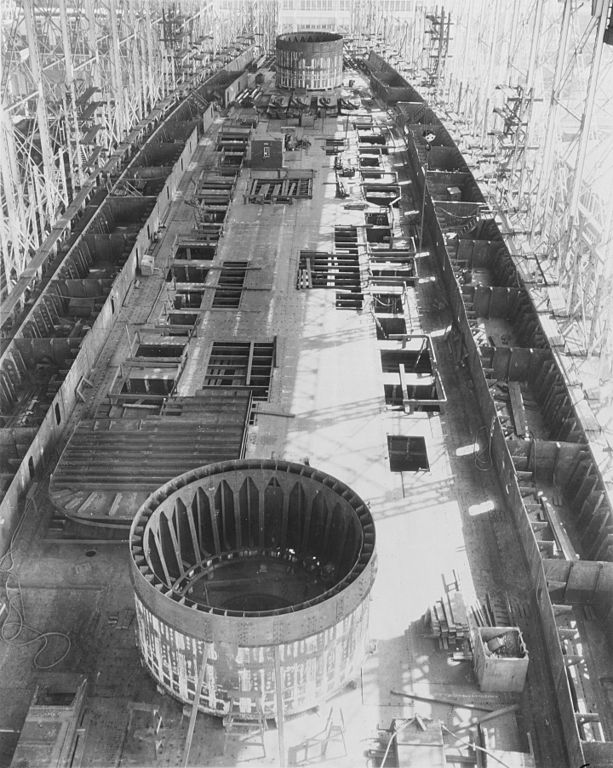
USS Saratoga CC-3 in construction, before reconversion on 8 March 1922, after her construction had been suspended. The circular barbettes on blocks on her deck were intended for the battlecruiser’s main battery
Development:
The new design was based on their hull, by then quite advanced (more than 35%). Compartimentation, upper framing, and even the armored belt were simply reduced in height. All the work was done on the design of a huge one-storey hangar and then the flight deck. The military at that time who still did not see the potential of the nascent air force, insisted that she would be able to defend herself, demanding the installation of a heavy cruiser armament and all defensive armament, guidance and artillery facilities needed. When the numerous boilers that powered these ships to more than 33 knots were truncated in a single massive funnel and the entire superstructure move to port, considered more practical for right-handed tendencies of airplanes landing. But also well to the specific maneuvers of pilots at the time, and interference of smoke. Much of the original design was based on the report written by a delegation of engineer officers who went to study the HMS Furious in operations.
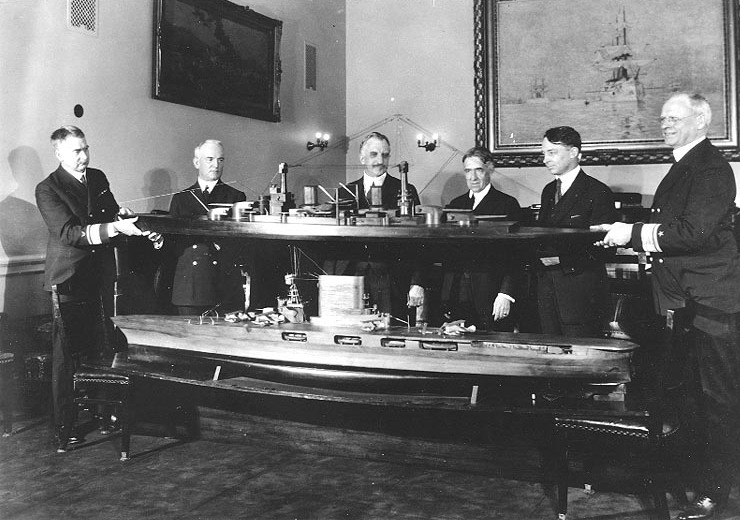
Lexington conversion discussed at the Navy dept. in 1922.
When two of the unfinished battlecruisers were designated for completion as carriers, they were the most advanced in construction. But converting them was a severe undertaking. Such conversion was marred by compromises and mishaps bron from competing visions of the USN that were quite fluid at the time. Unlike specifically designed carriers from the outset, they were the object of countless detail attention but ultimately proved ill-suited as aicraft carriers, only capable of a large air group when completed, but it shrank to half size in 1944 on Saratoga due to the aircraft going twice as much heavier and bulkier.
Compared to standard carrier designs they would possess however a far better anti-torpedo protection, as well as larger magazines for aircraft bombs (former main gun magzaines) a large aft elevator 28 feet (8.5 m) tall and more room for aircraft landings. The conversion would cost 0.5 knots (0.93 km/h; 0.58 mph) in speed compared to a tailored desig, and having as major drawback a 16% less hangar space already as well as aviation fuel due to her narrower lines aft. Costs were comparable however. It was estimated at the time that a brand-new aircraft carrier would cost $27.1 million. versus $22.4 million for conversion but htis was added to $6.7 million spent already on the battlecruiser construction for $28.1 million, above a tailored carrier.
At the time they were made “outlaw” in 1922 the US battlecruisers competed with the already buiding Amagi class, and British G3 class. The Congress just opposed to waste the $13.4 million already spent in construction, but the Navy eventually rescinded its preventions after much internal discussions.
However there was a catch. The treaty barred any country to built carriers above 27,000 tons. The battlecruisers were close to the 42,000 tonnes mark standard, and the hangar would add even more weight, so this figure was likely to go up, unless much of the armpur was removed (the planned turrets were immensely heavy as well).
Tonnage Challenge and Treaty ruses
The task given by the Navy to the Bureau of Construction and Repair (BuC&R) appeared thus, daunting to say the least. Faced was that impossible tonnage cap they just flat out expressed that no amount of redesign would meet this figure. Some in the Navy thys called for an exception, spearheaded by Assistant Secretary of the Navy Theodore Roosevelt Jr.. It was added to the treaty while still in discussion, allowing capital ships conversion up to 33,000 ton. With 6000 tons more, this looked more realistic, but that was still 11,000 tonnes to spare. Indeed BuC&R also adocating removing half the power plant in addition to the armour, but it would have made these ships slow, in the range of 18-20 knots at best. The Navy General Board refused to consider this an option. Great speed was seen and adantage to keep pace with the newt composite light battle squadrons composed of cruisers and destroyers all cranking up at 33 knots. Neverthless, by getting creative in interpretiation of a treaty clause, there was a potential way out:
No retained capital ships or aircraft carriers shall be reconstructed except for the purpose of providing means of defense against air and submarine attack, and subject to the following rules: The Contracting Powers may, for that purpose, equip existing tonnage with bulge or blister or anti-air attack deck protection, providing the increase of displacement thus effected does not exceed 3,000 tons (3,048 metric tons) displacement for each ship. Chapter II, Part III, Section I, (d))
Without it conversion was just not feasible. Estimates of 1928 presented a final, actual tonnage of 35,689 tons and 35,544 respectively for the two sisters. On official lists they were listed as “33,000 tons standard” with the footnote reading “does not include weight allowance under Ch. 2, pt. 3, Sec. 1, art. (d) of Washington Treaty for providing means against air and submarine attack”.
With this battle won in 1922, engineerers trie to squeeze anything possible to get the ship light enough and stable at the same time.
Construction
After three years of work, the ships were ready for launch in 1925. This was done in October with the sponsorship of Mrs. Theodore Douglas Robinson, secretary of the navy’s wife at the White House. It was one of the largest navy days, inaugurating a new generation of officers and theorists, viewed with suspicion, however, by the admirals of the old school (Mahan). The first air complement, of 63 aircraft, was judged at the time acceptable but appears reduced depending on the size of the ship, and the respective size of the aircraft.
But the latter, biplanes that hardly exceeded 250 kmh, could not fold their wings, and in general, the design of the hangar had been contingent by many compromises due to the origin of these ships. Both “Lex” were prototypes in many ways…
Design of the class
CV-2 USS Lexington, original blueprint series from the archives – external arrangement (outboard profile, starboard) [5942×1776]
byu/Amiral_Crapaud inWarshipPorn
Hull and general design
The ships as completed ion 1927-28 measured an exact 888 feet (270.7 m), for a beam of 106 feet (32.3 m), given them a 8.4 beam to lenght ratio, and a draft of 30 feet 5 inches (9.3 m) deeply load. This made for a good base for stability, provided engineers managed to build a lighte nough hangar structure and deck. USS Saratoga ended with a standard displacement of 36,000 long tons (36,578 t), and 43,055 long tons (43,746 t) deeply loaded.
One of their most innovative features was their bulbous bow also called “Taylor bow” after the inventor Rear Admiral David W. Taylor, Chief Constructor at the Bureau of Construction and Repair in the last World War. It’s amazing to sthink his invention would need more than half a century to mature and becoming mainstream in naval construction for heavy ships. It was the result of the result of advanced towing tests started in 1910 with models. These showed that such bow reduced turbulences and water resistance at 6% at high speeds and reinforced buoyancy, supporting the forecastle and reducing hull’s bending stress. A disadvantage was to create a thick layer of water in the bow wave, creeping up along the forward section of the waterline at higher speeds, and only reduced by careful design and waterline, which was done for the Lexington class.
The full plans from the official 1927 USN booklet, 1/35 scale.
The waterline was well profiled with fine entry and gradual curves on either fore and aft sides. Other than that, the upper hull design presented both pointy ends. The stern presented a “Y” shaped section flat until in slight curved up to the landing lip of the deck. The most sticking aspect is the very large, tall funnel which was an immediate rcoignition giveaway, completed by a cruiser style brige immediately forward of it, inherited from her imposing main artillery. Air direction and command was less a thing back then. And unlike posterior designs, this island was separated from the funnel block. Still, the latter presented a set of hanging bridges to watch over air operations on deck fore and aft, witl intermediate walkways. Heat insulation was thus a very important point to avoid personal to “cook” into these structures.
The forward bridge presented the main pilot house, above the conning tower, a small overhanging structure, whikle the bridge was three faceted with an outer deck bevelled wall, above was an open bridge and the 20ft forward rangefinder, then the map room with a set of three 24 inches projectors. Then above, supported by the foemast led of the tripod, the spotting bridge and fire control station for the 8 inches guns, and the 5 inches fire control aboce, then the top mast platform supporting the 5(inches director and two rangefinders of either sides. The aft tripod supported the wireless pole mast with flag and truck lights, supporting the TU antenna going forward on deck and aft, the TAQ and TP antena cables anchored on the roof of the funnel block.
The latter saw utility boats close to its side, three 40ft motor boats under axial davits, a 40ft motor launch suspended below, then two 26 ft motor whal boats under fixed outer davits close to the bridge. Other boats were anchored on the other side in niches.
The main funnel supported forward the aviation control station accessible by ladders with its roof bridge accessible by a staircase. The aft part of the funnel suppoted the 8 inches fire control station anchored on an aft half mast, topped by a platform supporting a main rangefinder, and 5 inches gun director. The funnel top was circled by a large walway platform supporting 36 inches projectors on each corners and six cal.50 on either side, with the cooling water tank below.
Of course apart the funnel the other aspect unique to these ships were the superfiring fore and aft 8-in guns turrets, which design was pretty unique to these ships. They were very lightly protected for obvious stability reasons and the barrels were topped by 1-pdr subcalibers used for close defence and aiming, later deleted.
There were six 5-in guns on either side, three sponsoned forward close to the first main turret, and three aft, towards the deck’s end and close to the portable kingpost and boom.
There were also four sponson ed 3-inches AA guns sponsoned on each corner of the deck, and two 6-pdr saluting guns on a platform bewteen the bridge and funnel.
The prow not chin only had a reduced bulge, but it had a V style enclosed bow with three main anchors and topped by the ford anchor.
The rudder was “L” shape and quite large, close to the stern. The hangar was enclosed with electrical lighting, except for door style openings amidships.
Powerplant
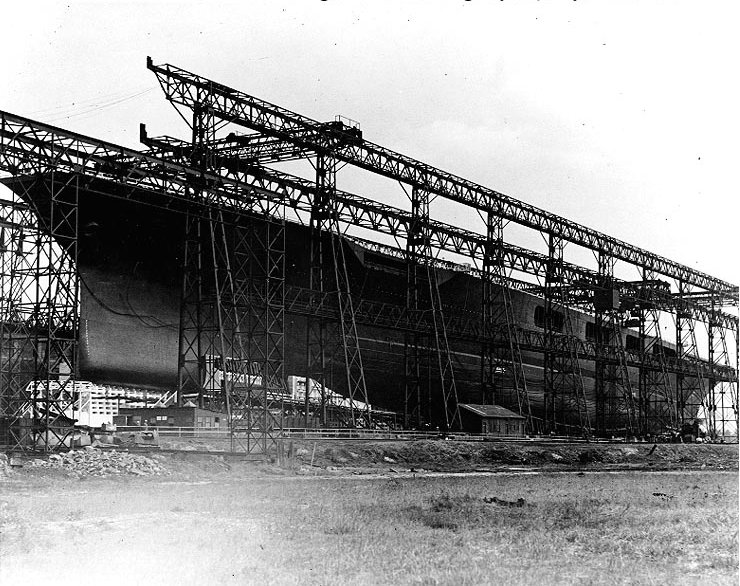
USS Lexington in construction, May 1925, see the bulbous bow.
Turbo-electric propulsion had been chosen for the battlecruisers originally, as it was the new standard for capital ships, driven in addition by companies which struggling to produce very large geared turbines. Although quite heavy, they were retained for the conversion, as adding a wlecome weight low for extra stability. The main advantage of turbo-electric drive was use of flexible electric cables instead of bulky steam-lines running into the compartments and sensible to damage. Instead, cables were resik-free and allowed to be placed farther aft to reduce vibration and weight, shortening much the propeller shafts. This also enabled these carriers to go astern at full power without a separate reverse turbine thanks to simple electrical polarity. They could also be distributed to all four propellers even if on if one turbo generator failed to avoid imbalance, and operating generators in a flexible way at low speed with higher loading and greater efficiency overall.
This Turbo-electric drive during their career proved to be efficient, rugged and always reliable. But it was finnicky to maintain in the long run also. Ventilation systems were also needed to to dissipate heat and keep out salt air, and it was still sensible to moisture and flooding due to battle damage. This high voltage became a death sentence in that case for the crew.
Each propeller measured 14 feet 9 inches (4.50 m) in diameter. Each of the four propeller shafts benefited from two 22,500-shaft-horsepower (16,800 kW) electric motors in tandem. The challenged to build them is that they were five times larger than any earlier electric motor and a marvel of engineering by themselves, displayed notably in Pop Mech. Four General Electric turbo generators powered each propeller shaft, eacg rated for 35,200 kilowatts (47,200 hp) and 5,000 volts or 4620 amps of direct current, DC. Each of the four AC alternators produced 40,000 kVA.

To produced this electricity in the first place were no less than sixteen water-tube boilers ingerited from the battlecruisers, and each in their own individual compartment to prevent flooding. Steam was sent to the generators at a working pressure of 295 psi (2,034 kPa; 21 kgf/cm2), temperature of 460 °F (238 °C). The turbo-electric drive was designed for a grand total of 180,000 shaft horsepower (130,000 kW), otally unprecedented in 1920. They had been tailored to propel these large ships at 33.25 knots (61.58 km/h; 38.26 mph)
The sea trials in 1928 showed that in reality they could produced more, up to 202,000 shp (151,000 kW) and so provide for an amazing 34.5 knots (63.9 km/h; 39.7 mph) which was destroyer speed. This had of course huge benefits, not only to follow the fastest battlefleet and evolved with great tactical flexibility with capital ships squadrons (21 knots), but to escape cruisers and battleships, as well as helping aircraft taking off when placed in the wind.
There were also six 1,010 hp (750-kw) DC turbo generators installed in the upper levels of the two main turbine compartments for basic power needs when the machinery was shut cold.
The range was also impressive. These ships had been designed to roam the Pacific. There was a maximum of 6,688 long tons (6,795 t) of fuel oil of which 5,400 long tons (5,500 t) were usable immediately, the rest was present only as ballast in the port fuel tanks for extra stability. In case of emergency they could be pumped into the main tanks. This made for a maximal range of range of 9,910 nautical miles (18,350 km; 11,400 mi) at 10.7 knots (19.8 km/h; 12.3 mph) based on 4,540 long tons (4,610 t) oil only. With the total, a ferry range of 15,000 nm was possible. This was possible to leave San Diego, reach Madagascar and back without stopping once. src.
Armament
Oddly it was the Bureau of Construction and Repair, not the admiralty, which was to blame for the idea that 80 aircraft aboard did not constituted a sufficient armament by itself. This also reassured the most vocal admirals of the “anti-Mitchell faction” that emerged in 1925. Thus the design was amended to included a substantial gun battery:
-Eight 8″/55 caliber guns in four twin gun turrets (same as any heavy cruiser) fore and aft of the island.
-16x 5-in/38 Mark 12
From 1939:
-4x 3-in/55 Mark 10
-20x 0.5 in Browning LMG
Main: 8x 8″/55 caliber

The two pairs of superfiring turrets were mounted above the flight deck, starboard side, two before the bridge, two behind the funnel. They could fire to both sides on paper but all knew what meant a full broadside just above the canvas and wooden aircraft of the time on deck. If they would fired to port so across deck, the blast not only would have damaged the unfortunate aircraft present in their vicinity quite badly, but also the flight deck. The mounted enabled a depression of −5°, elevation to +41° and they could be loaded at an angle of +9°.
Mk 9 guns in four 190-ton twin turrets
Rounds: 335 pounds (152 kg) A.P. or 260 pounds (118 kg) H.E.
Muzzle velocity 2,800 ft/s (850 m/s)
Maximum range of 31,860 yards (29,133 m).
Life expectancy was 715 effective full charges
See on navweaps
The Navy made plans to remove the eight-inch (203 mm) gun turrets in 1940 and replace them with four twin 5″/38 caliber dual-purpose gun turrets (the standard mounting on U.S. battleships and cruisers) and lexington’s eight-inch gun turrets were removed in early 1942, but replaced by seven additional quadruple 1.1-inch gun mounts but she was sunk before the turrets were installed. Saratoga was also redically modernized after she was torpedoed in early 1942 and heir eight-inch guns turrets ended as coast defense weapons on Oahu.
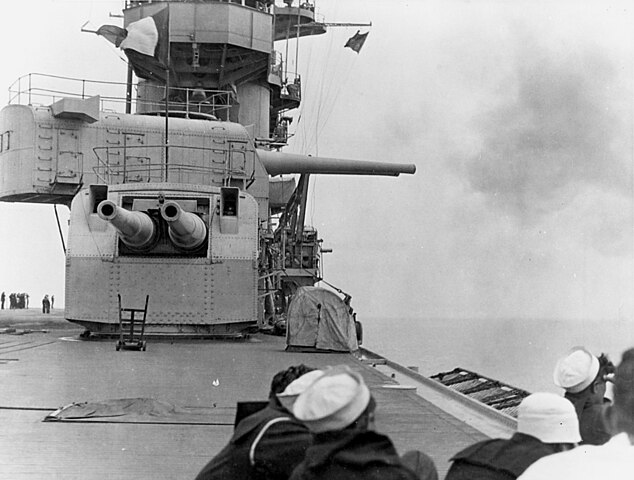
Secondary Guns
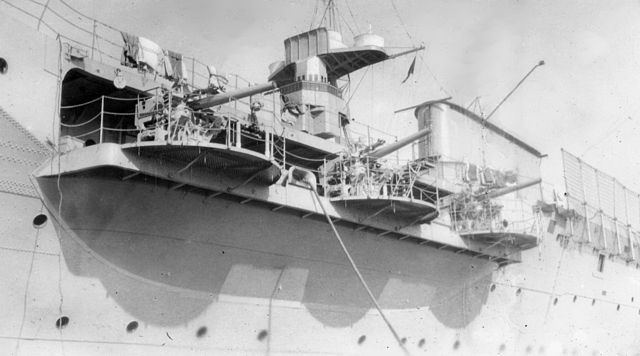
The two carriers came with six 5-in/25 guns. They were presented in detail on previous posts, and have a full entry here.
Heavy AA: 5-inches guns
The Lexington class received originally a dozen 5″/25 caliber guns: Six on each side, in single mounts, three forward and three aft of the flight deck.
The 5″/25 caliber gun entered service as standard heavy anti-aircraft ordnance, entering service just in time for the new Washington Naval Treaty cruisers commissioned in the interwar. The engineers at the time tried to create a gun powerful yet light enough to be rapidly trained manually. It ended as well mounted on pre-WWII battleships and aircraft carriers until replaced by famous dual-purpose 5″/38 caliber gun derived it. 5-in/25 removed from battleshipsended on new submarines also by late 1943, until replacement by a new one by mid-1944,. The name was for 5 inches (127 mm) in diameter, 25 calibers long for the barrel or 125 inches, 3.2 meters. It was sometimes used as a dual-purpose gun but was kept mostly as anti-aircraft gun.
At the same time, the five-inch (127 mm) 25-caliber guns were to be replaced with more 5″/38 guns on a two for three basis, due to their greater weight.
They fired a 55-pound (25 kg) shell as a muzzle velocity of 2,600 ft/s (790 m/s)
But also a 53.85-pound (24.43 kg) projectiles at a muzzle velocity of 2,110 ft/s (640 m/s)
Rate of fire was up to 20 rounds per minute.
Range 18,200 yards (16,600 m), 17,700 yards (16,200 m) at +30° elevation, maximum elevation of +85°.
Medium AA: 3-inches/50 guns Mark 10
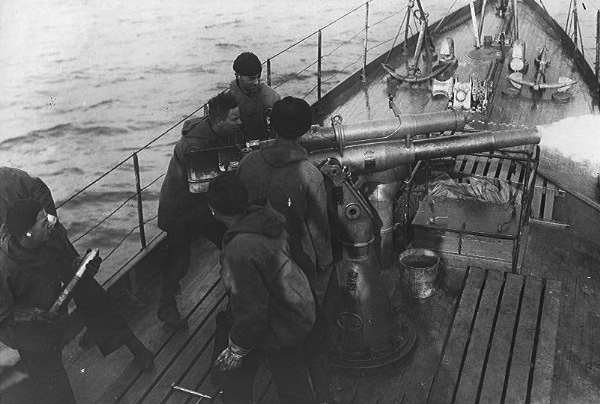
They were added at all four corners in sponsons in 1929-30. The Mark 10 was a 1915 design on a 3 tons (3.1 mt) lightweight Mark 11 mount for 360 degrees (here 180).
Gun Weight was 1,760 lbs. (798 kg) with mount, 159.7 in (4.055 m) long overall but the bore Length was 150.3 in (3.816 m).
Rate Of Fire was 15-20 rounds per minute. These were fixed 24 lbs. (10.9 kg) rounds, HC, MV 2,700 fps (823 mps).
Light AA
As built, the ships were not fitted with any light AA guns, but a few .50-inch (13 mm) water-cooled M2 Browning heavy machine guns were fitted shortly after commissioning and the numbers gradually increased over the 1930s. Lexington had 24 HLG still when sunk in early 1942.
Liqui cooled 0.5 in HMG:
45 g round, muzzle velocity 2,930 ft/s (890 m/s), Effective range 1,600 yards (1,500 m). Rate of fire of 550–700 rounds per minute.
They amazing reliablility was marred by a round too light and too short ranged.
They were replaced by tge license-built Oerlikon 20 mm autocannon from 1942 on a one-to-one basis.
Oerlikon 20 mm:
This 0.79 in autocannon fired a 272-pound (0.123 kg) HE shells at 2,750 ft/s (840 m/s).
Maximum range was 4,800 yards (4,400 m), effective range 1,000 yards (910 m).
Cyclic rate of fire 450 rounds per minute, practical 250-320 rpm, using magazines.
USS Saratoga in late 1942 had 52 of these already.
Read more
1.1-in Mark 1 “Chicago Piano”
The other interwar addition was the quadruple 1.1-inch light AA installed in the earlt 1930s. It had teething problems, so five single 3″/50 Mk 10 AA were installed in 1940 instead.
13-pound (5.9 kg) shells at MV 2,700 ft/s (820 m/s). +85° elevation, ceiling 29,800 feet (9,100 m).
Five quadruple 1.1-inch mounts were installed on Lady Lex by late 1941-early 1942.
0.9-pound (0.41 kg) shell MV 2,700 ft/s (820 m/s), effective range 3,000 yards (2,700 m), 150 rpm.
Not successful in service, replaced by 40 mm Bofors from late 1942.
40-millimeter (1.6 in) Bofors AA
The 1.6 in, 1.98-pound (0.90 kg) HE round had a muzzle velocity of 2,890 ft/s (880 m/s).
Maximum range was 11,000 yards (10,000 m), effective 4,000–5,000 yards (3,700–4,600 m).
Cylic rate of fire 160 rounds per minute.
The were installed in quadruple and twin gun mounts. USS Saratoga had 23 quadruple, two twin mounts by early 1944 alrady fora total of 96 of these. In addition to the 20 mm adnd excellent 5-in/38 USS Saratoga was ready for Kamikaze attacks.
Protection
-The waterline belt started at 7–5 inches (178–127 mm) from top to bottom, angled outwards 11° at the top. This increased a bit thickness in direct fire and and close-range, but it was now tall at just 9 feet 4 inches (2.8 m), so could be overrun by plunging shellfire. It was spread over 530 feet (161.5 m) amidship.
Forward, the belt was closed by a bulkhead tapering from 7 to 5 inches thick.
Aft, it wasd closed by a terminated at a 7-inch bulkhead.
-The third deck, over machinery and magazines was composed of two layers of special treatment steel (STS) 2 inches (51 mm) combined.
-The steering gear received the same but three layers, for 3 inches (76 mm) on flat, 4.5 inches (114 mm) on the slope.
-The gun turrets were protected only with .75 inches (19 mm) of armor to avoid stability issues. It could block shrapnel but nothing else.
-The conning tower had 2–2.25 inches (51–57 mm) STS walls. Its communications tube had 2-inch walls, from the conning tower to the lower conning position, third deck.
-The torpedo defense system comprised 3-6r medium steel protective bulkheads between .375 and .75 inches (10 to 19 mm). The spaces between them could be used as fuel tanks. Heavy oil were known to slow down any incoing torpedo once it penetrated.
Sensors
The two superfiring eight-inch turrets were directed by two Mk 18 fire-control directors (fore and aft spotting tops) with as backup two Mk 30 rangefinder at the rear of the superfiring turrets for local control. There was a 20-foot (6.1 m) rangefinder on top of the pilothouse feeding range information for the directors.
Each group of three 5-inch guns received data from a Mk 19 director, mounted on each side of the spotting tops.
The obsolete Mk 19 directors were to be upgraded by two heavier Mk 33 directors in 1941 on the fore and aft 5-inch spotting tops but this was cancelled as new Mark 12 dual-purpose guns were installed to replace the 8-in gun turrets by early 1942.
As for radars, USS Saratoga received a RCA CXAM-1 early warning radar by February 1941 while in Bremerton. It ended on the forward lip of the funnel and the control room was installed directly below the aerial instead of the secondary conning station. Two FC (Mk 3) surface fire-control radars was also mounted later in 1941 bur removed along with the main armament in January 1942.
The new 5-in/38 turets were controlled by two Mk 37 directors combined with a FD (Mk 4) anti-aircraft gunnery radar.
The removal of the 1.1-inch by 40 mm Bofots in 1942 saw the addition of five Mk 51 directors as well.
Better radars were added in 1942 and January 1944 for Saratoga, see the modernization records below.
Air Facilities

Martin T3Ms and Curtiss F6C on Lexington, 1928, showing her teak deck and aft lift.
As built these ships had a teak cladded flight deck (planks could be easily replaced) over steel, with a total surface of 7,349 m² (80,000 Ft Sq) for 268.2 meters long (880 ft) x 27.4 m (90 ft) and a hangar that was 129.2 meters (424 ft) x 22.6 meters (74 ft) x 6.4 meters (21 ft) in lenght, width and height or 2,920 m² (33,528 square feet), 18,687 m³ (660,000 Sq Cu). Note that 6.4 meters or 21 feet was well above the max tail height of any model in service in 1927. This was in fact the largest enclosed space afloat, civilian or military. The hangar width varied however between 68 to 74 feet (20.7 to 22.6 m) due to the bulky funnel uptakes and boat compartments. The hangar height stayed the tallest before the Forrestal-class supercarriers of the fities. Some argued that engineers could have manage to make superposed two hangars, inluding the lower one used only for fighters and stores, but stability was constrained by the origininal hull, which was tailored for speed.
There was also aircraft repair shops, 108-foot (32.9 m) long aft of the hangar, and below the main storage space for disassembled aircraft which was itself 128 feet (39 m) long. The hangar was divided by a single fire curtain forward of the aft aircraft elevator, as fire precautions were just in their infancy at the time. There were portable pumps and hoses, an alarm, but no other measures were taken. Ventilation was poor also. Spare parts suspended under the ceiling was however more theoretical than feasible, and depended on the aircraft types stationed below.
The Elevators: There were two of these, hydraulically powered, centerline. The fore lift measured 9 x 18.1 meters (29 x 59 ft) for 7.3t (16,000 pounds (7,257.5 kg) capacity), and an aft lift 8.9 x 10.6m (29 x 35 ft), 2.7t. It was mostly used for lifting supplies. There was a 20-by-26-foot (6.1 by 7.9 m) section of the flight deck adjoining the rear edge of the elevator down the centerline that could be removed to lift aircraft too long for the lift platform. Capacity was 12,000 pounds (5,400 kg) and it was able to be raised at 2 feet per second (0.61 m/s). The aft elevator being able to lift 6,000 pounds (2,721.6 kg) was mostly for stores.
Ammunitions were delivered from the magazines by two hydraulically powered bomb lifts, one torpedo lift located on the sides.
There was one flywheel-powered 47m (155 ft) catapult F Mk 1 forward which could launch a 10,000-pound (4,536 kg) aircraft at 48 knots (89 km/h; 55 mph). It was removed in 1934 as unnecessary.
There was also a folding crane with a 10 long tons (10 t) capacity on the flight deck edge, forward of the gun turrets to retreive the onboard Grumman JF floatplanes.
Aviation gasoline was spread for safety into eight separate compartments, part of the torpedo protection system. Sources diverged on capacity, either 132,264 US gallons (500,670 L; 110,133 imp gal) or 163,000 US gallons (620,000 L; 136,000 imp gal) as built. This was extended on Saratoga post-1942 to 520,500 liters.
Air Group
The Lexington-class as designed could house 78 aircraft, ideally 36 bombers. But as the navy started to count aicraft in reserve and ion spare parts, this started to rise as they were located unused spaces under the hangar ceiling.
The class is fascinating in that it operated virtually all models in service in the USN from 1925 to 1945, so two decades. So to start, here is a list by types:
Fighters: Curtiss FB, F6C Hawk, Vought FU, Boeing FB-5, F2B, F3B, F4B, Grumman FF, F2F, F3F, F4F Wildcat, F6F Hellcat, Vought F4U Corsair
Torpedo bombers: Douglas DT, Martin T2M (SC), Douglas T2D, Martin T3M, Douglas TBD Devastator, Grumman TBF Avenger
Dive Bombers: Vought SBU-1, Northrop BT-1, Vought SB2U Vindicator, Curtiss SBC, SB2C Helldiver
Recce/multipurpose: Vought UO, O2U Corsair, VE-7, VE-9, SBU-1, Grumman JF
By 1936 for example, the typical air group for both comprised 18 Grumman F2F-1, 18 Boeing F4B-4 fighters, nine F2Fs in reserve. There were also 20 Vought SBU Corsair dive bombers, 10 spare and 18 Great Lakes BG torpedo bombers, nine spares, plus Misc. two Grumman JF Duck amphibians, one spare, three active, one spare Vought O2U Corsair for observation or 79 active aircraft, 30 spares so 109 on paper, which was properly enormous for the time. With aicraft wieght and size rising by 1944 it was far less stellar. Unlike Essex class carriers there was little room for deck parking either.
In 1937 USS Lexington had eighteen Grumman F2F-1, eighteen Boeing F4B-4, eighteen BG-1 TB, twenty Vought SBU-1 and three O2U-3 Corsair as well as two 2 JF “duck” floatplanes.
By early December 1941, USS Lexington was ferrying 18 U.S. Marine Corps Vought SB2U Vindicator dive bombers to Midway and still had 65 in hangar (including 17 Brewster F2A Buffalo fighters). At the Wake Island relief expedition her sister USS Saratoga comprised a CAP of 13 Grumman F4F Wildcat fighters and a strike force comprosed of 42 Douglas SBD Dauntless dive bombers, 11 Douglas TBD Devastator torpedo bombers while taciing 14 Buffalos for the USMC at Wake. Before the Battle of the Eastern Solomons Saratoga had 90 aircraft on board: 37 Wildcats, 37 Dauntlesses, 16 Grumman TBF Avenger.
In fact in 1942 both carried 22-36 F4F Wildcat, 36 SBD Dauntless and 12 TBD Devastator or 15 TBF Avenger (for Saratoga).
In 1944, the surviving Saratoga carried 27 F6F Hellcat, 24 SBD Dauntless and 18 TBF Avenger.
In early 1945 she had 53 Grumman F6F Hellcat fighters on board, used with rockets for ground attacks, and 17 Avengers.
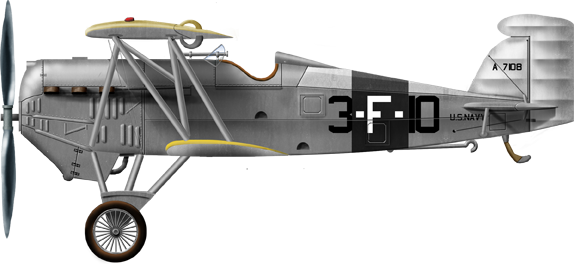
Boeing FB-5 fighter from VF-3B, USS Saratoga, 1927
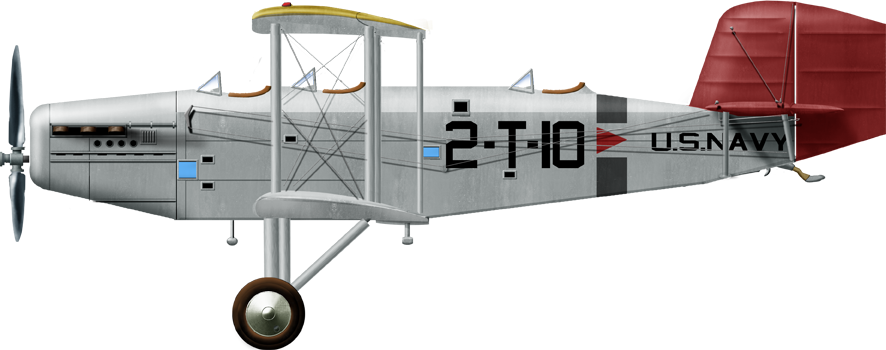
Martin T3M 2-T-10 torpedo bomber, from VT-2 USS Saratoga 1928.
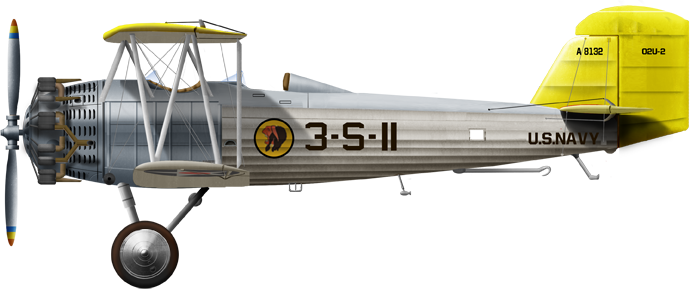
Vought O2U-2 VS-3B observation aircraft, USS Lexington 1928

Grumman FF-1 multirole aircraft, V5B, USS Lexington 1933

Grumman F3F-1 fighter CV-2 USS Lexington, 1937

Douglas TBD-1 torpedo bomber VT-2 USS Lexington 1939

Vought SB2U-1 Vindicator dive bomber CV-3 USS Saratoga, 1939

Brewster F2A-2 fighter, USS Lexington spring 1941
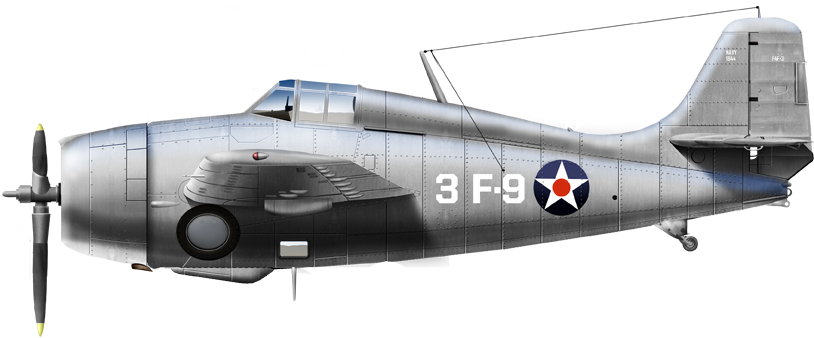
Grumman F4F-3 fighter USS Saratoga spring 1941

Douglas SBD Dauntless dive bomber, USS Lexington, Battle of the Coral Sea 1942
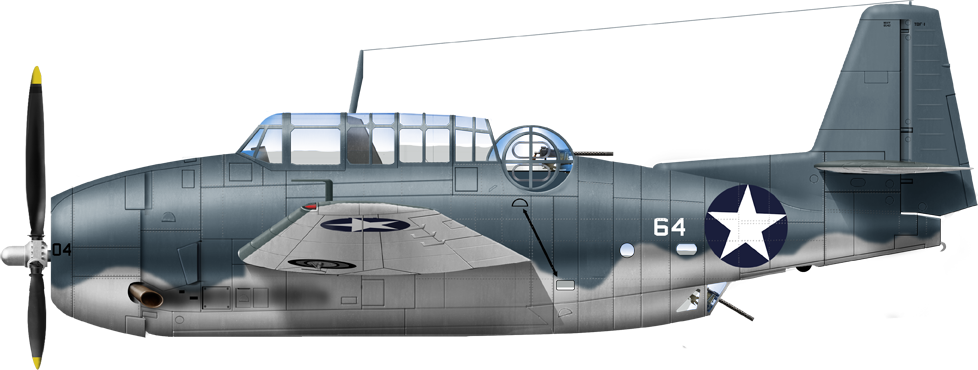
Gruman TBF-1 torpedo bomber VT-8, USS Saratoga, Solomons late 1942

USS Lexington
⚙ specifications as completed |
|
| Displacement | 36,000 long tons (37,000 t) standard |
| Dimensions | 888 x 106 x 30 ft 5 in (270.7 m oa x 32.3 m x 9.3 m) deep load |
| Propulsion | 4 shafts, sets turbo-electric transmission, 16 water-tube boilers 180,000 shp (130,000 kW) |
| Speed | 34.5 knots (63.9 km/h; 39.7 mph) max trials 36 kts |
| Range | 10,000 nmi (19,000 km; 12,000 mi) at 10 knots (19 km/h; 12 mph) |
| Armament | 4×2 8-in (203 mm), 12× 5-in (127 mm) AA, later 4x 3-in AA, 20x 0.5 cal. AA |
| Protection | Belt 5–7 in (127–178 mm), deck 0.75–2 in (19–51 mm), Gun turrets: 0.75 in (19 mm), Bulkheads: 5–7 in (127–178 mm) |
| Sensors | Artillery FCS |
| Air Group | 90 in 1927, see notes. 1 catapult, 2 elevators |
| Crew | 2,791 including aviation personnel (1942) |
Modifications
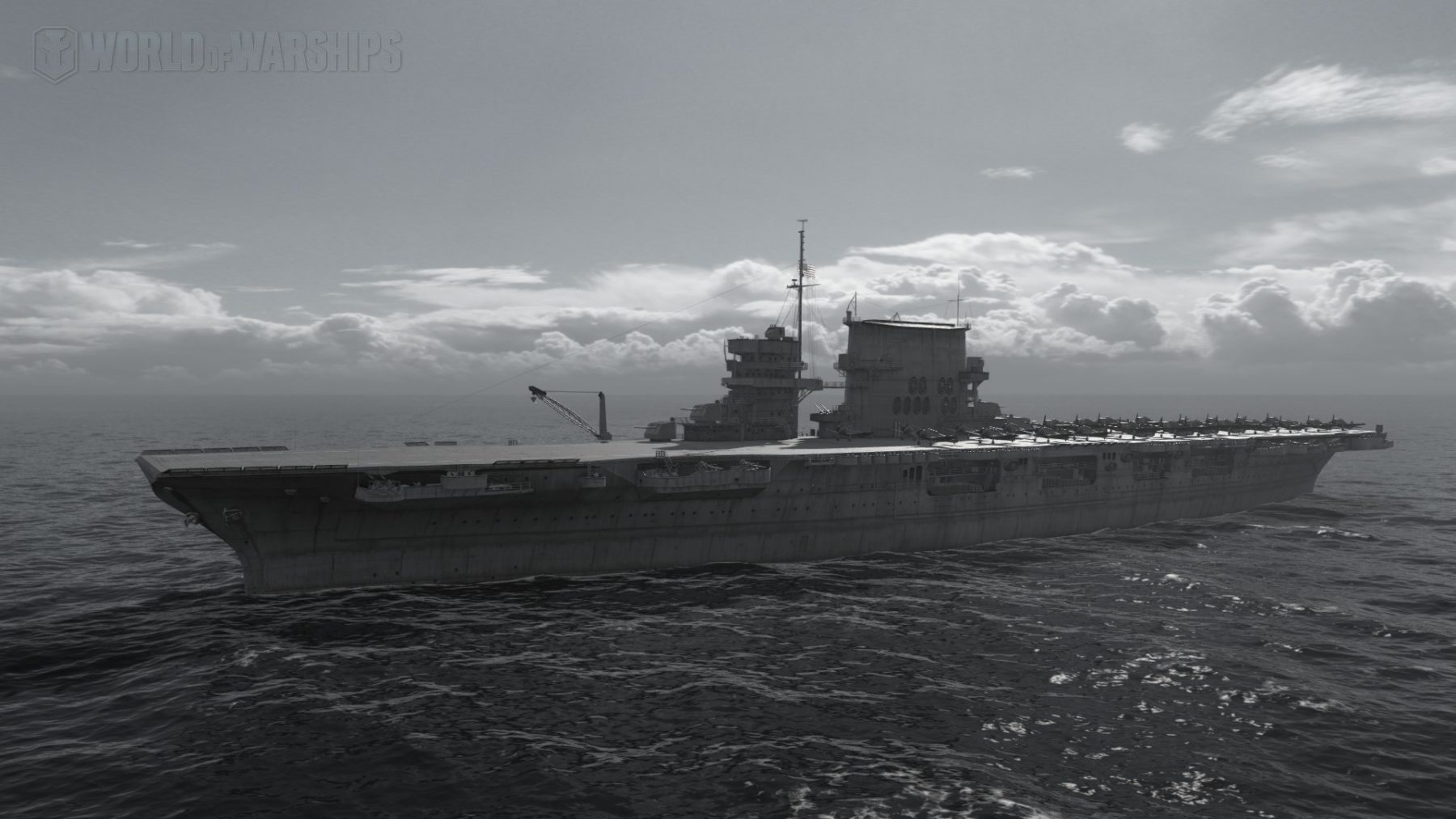
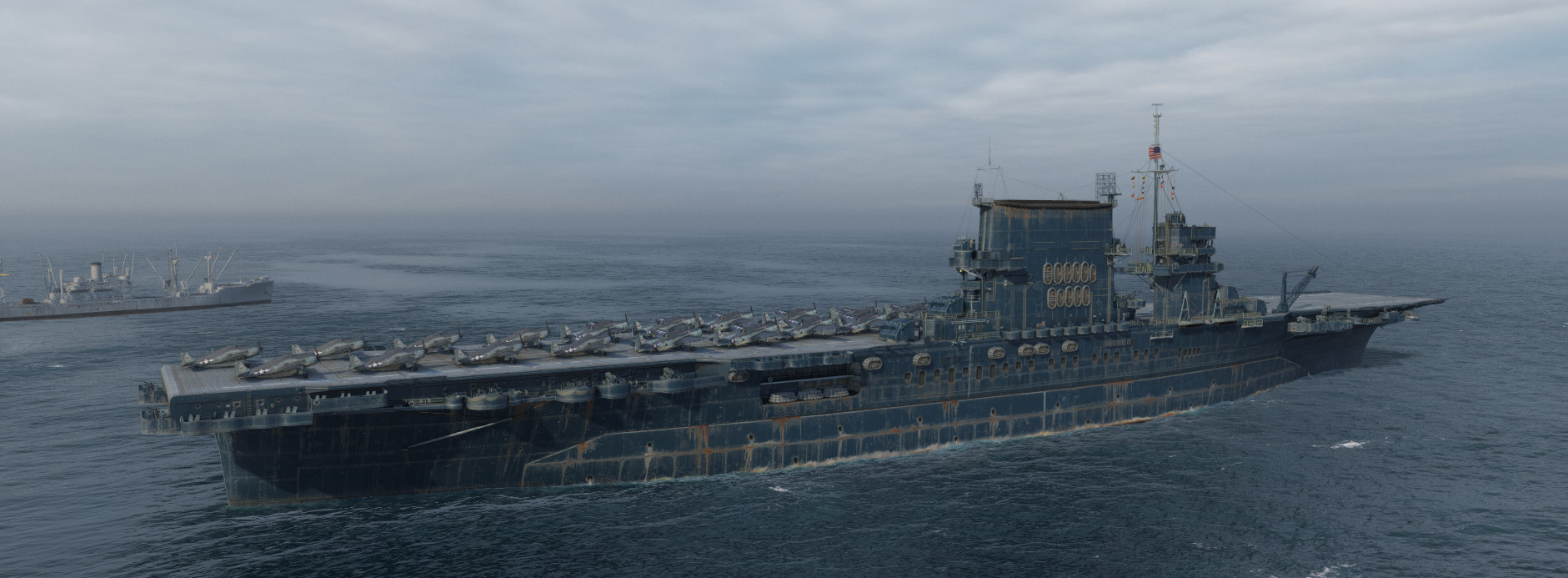

Renditions on world of warships
In 1929 both received six 7.6mm (3-in)/90 AA guns and Saratoga was the first to receive two twin 12.7mm/90 Browning HMG.
In the early 1930s, USS Lexington received her 3-in/90 guns in turn. In 1934, both had their catapult and in 1936, Lexington received 28 singke 0.5 inches or 12.7mm/90 Browning liquid cooled HMG.
In 1937, Saratoga was given in the same, for the removal of its twin mount.
By the spring of 1940, both received four more single Browning 0.5 inches/90 and a CXAM-1 radar, very first generation.
In 1940 both saw the removal of four Browning and addition of five extra single 3-in/50 Mk 20 AA guns.
In 1941, both saw their removal and of five 3-in/50 guns for the installation in their place or five quadruple 28mm/75 Mk 1 “Chicago Piano”.
Early 1942 in Saratoga saw the removal of all her 28 remaining Browning 0.5-in/90 and installation of four quad 28mm/75 Mk 1 and thirty-two single 20mm/70 Mk 4 AA guns. Most were located on the top funnel walkway and the remainder in sponsons around the deck.
In April 1942, USS Lexington had her last refit, seeing the removal of her four twin 8-in/55 guns for the addition of seven quad 28mm/75 Mk 1 AA batteries and thirty two 20mm/70 Mk 4 Oerlikon plus addition of two Mk 4 radars for gunnery.


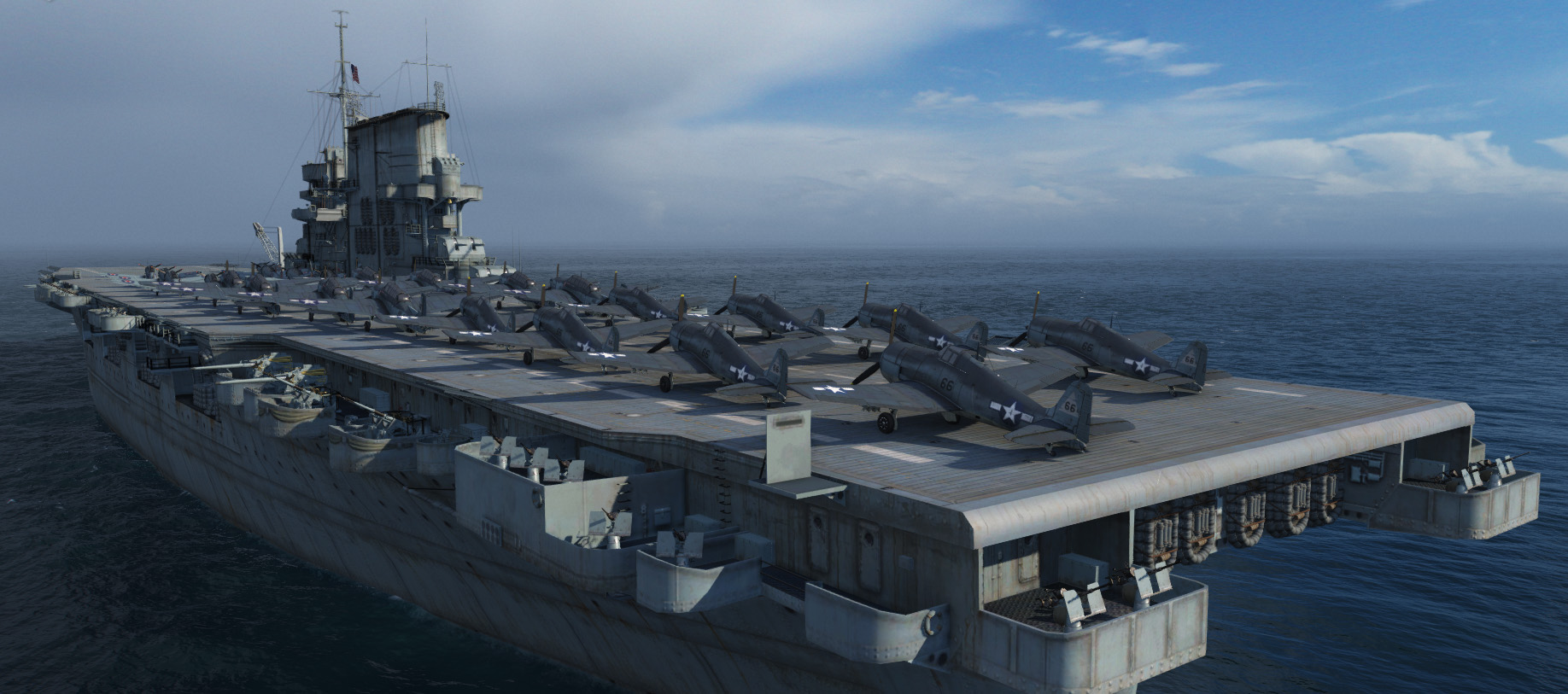
Rendition of USS Saratoga in WoW, first with grey livery and in 1944 camouflage.
In May 1942 Saratoga saw the intensive modernization the class needed after all these years: This saw the similar removal of her main gun, of all twelve single 5-in/25 guns, and of four quad 28mm/75, plus two single 20mm/70 and in exhanged in place of her former main turret had four twin 5-in/38 Mk 12 gun turrets (standard fleet carriers). She also had eight single 5-in/38 Mk 12 installed where the former /50 were located, plus four quad 40mm/56 Mk 1.2 Bofors.
Deck/hangar side, she received two H II catapults forward. Her radar suite was upgraded as well with an SC, two Mk 4 radars.
Her Flight deck was lengthened with an overall length now up to 277.2 m whil eht eflight deck superficy was ported to 7,595 m².
Breadth was increased with the addition of a starboard bulge, new beam now 34.1 meters, displacement 40,000 tons standard as described below.
Her hangar was reinforced to free extra space and was ported to 2,920 m² in surface, and 18,687 m³ in volume. This was also due to the new aircraft in service at the time.
Maximal fuel stowage rose accordingly to 9,748t and Complement grew to 3,373.

Liveries of both Saratoga and Lexington
In October 1942, she saw the removal of five quad 28mm/75 mount at last, for the gain of five quad 40mm/56 Mk 1.2 Bofors and 22 single 20mm/70 Mk 4 AA guns.
In January 1944 she had all 36 of her 20mm/70 Oerlikon guns removal and instead received fourteen quad 40mm/56 Mk 1.2, pllus two twin 40mm/56 Mk 1.2. This doubled her AA protection. She also received the SK radar and on the next summer the SM radar.
In May 1945 her inefficient aft elevator was removed and a new forward elevator, larger and stringer, fitted
In 1946 so before being decommissioned and later spent in a nuclear test, she had the above and kept sixteen 20mm/70 Mk 10 Oerlikon guns. Her capacity was down to 63 aircraft. She also had a comprehensive radar suite, comprising the SC and SK for aerial surveillance and first warning, as well as the surface search SM model and two Mk 4 radars for her 5-in/38 turrets.
⚙ specifications USS Saratoga in 1945 |
|
| Displacement | 40,000t standard, 48,552 tonns FL |
| Dimensions | 277.2 m x 34.1m |
| Speed | Circa 30 kts. |
| Armament | 4×2 5-in/38 Mk 32, 8x 5-in/38 Mk 33, 23×4 40mm/60 Mk 2, 2×2 40mm/60 Mk 1, 16x 20mm/70 Mk 10 |
| Sensors | SK radar, SM radar |
| Air Group | 63 |
| Crew | c3,000 |
 USS Lexington
USS Lexington
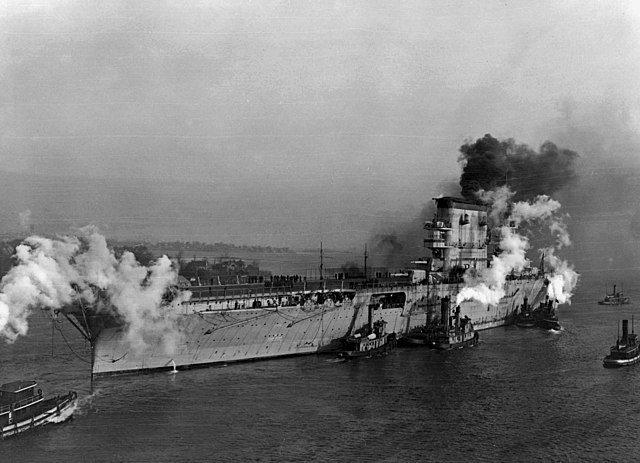
USS Lexington freshly completed, tugged out of the harbor for sea trials.
After fitting-out and shakedown, USS Lexington was transferred to the West Coast, arriving at San Pedro (Los Angeles) on 7 April 1928. In June she made a famous high speed run from San Pedro to Honolulu in 72 hours and 34 minutes, a world record at the time as no destroyer had enough fuel to do the same crossing (nor any cruiser). USS Lexington had San Pedro as homeport until 1940. Several Fleet Problems brought her via Panama to the Atlantic Ocean and Caribbean though. She was capital to make air support doctrine evolve and wrote the book on tactics that all future carriers officers would follow. Fleet Problem IX in January 1929 saw her at the head of the Scouting Force, failing to defend the Panama Canal against her sister Saratoga. Future scifi author Robert A. Heinlein was aboard on 6 July when “Lady Lex” was then under command of Captain Frank Berrien.
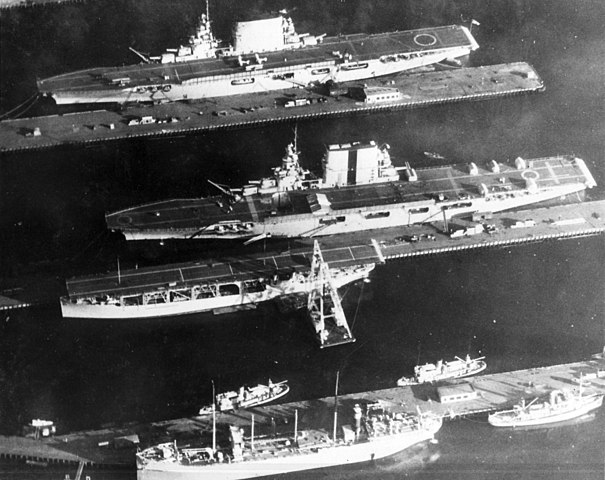
USS Langley, Saratoga and Lexington anchored at Puget Sound NyD, 1929
The 1929 western Washington state drought caused Lake Cushman nor providing enough water to the Cushman Dam No. 1, starving the city of Tacoma from electricity. The U.S. Navy sent Lexington from Puget Sound to Tacoma, entered the port where her crew and city’s engineers managed to install heavy electric lines to her own power system. She provided 4,520,960 kilowatt hours from 17 December to 16 January 1930 until the lake’ level rose again. This way she gave unprecedented incarnation to the comparison of a carrier having enough energy for a small city.
After Fleet Problem X in the Caribbean where she virtually sank Saratoga and Langley she went back for maintenance. Then at Fleet Problem XI the following month Saratoga “sank” her. She had her own flight deck “knock out” for 24 hours. At the time she was under command of no less than “semper iratus” Captain Ernest J. King, future USN CNO in WW2, the navy equivalent to Marshall. He started his command on 20 June 1930. Lexington teamed with Saratoga to defend the west coast of Panama in Problem XII (February 1931) and could not prevent the landing. All three carriers ended their exercise in the Caribbean. Later Saratoga successfully defended Panama against Lexington, King being ambushed by a destroyer sent by Rear Admiral Joseph M. Reeves on 22 March.
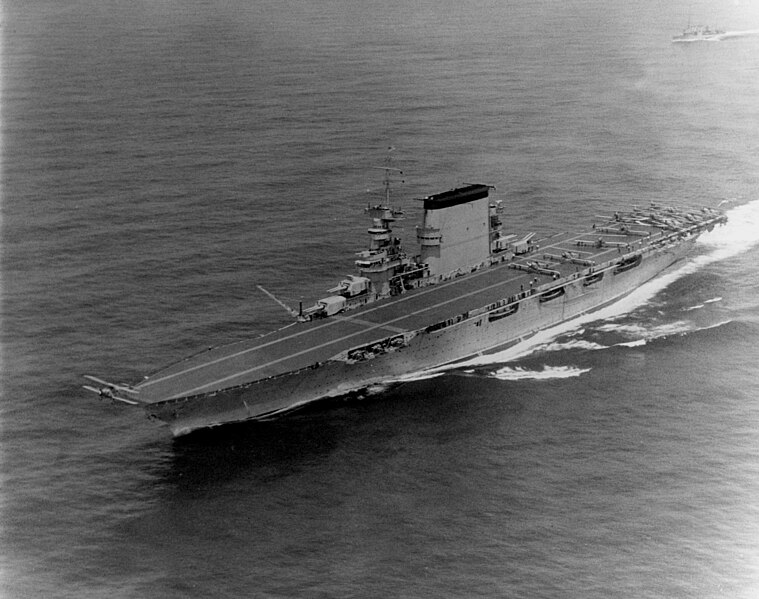
Lexington launching Martin T4M torpedo bombers in 1931
On 31 March 1931, Lexington helped survivors of an earthquake in Managua, Nicaragua. Her aircraft carried supplies and medical personnel. In the Grand Joint Exercise No. 4, both sisters launched a massive airstrike against Pearl Harbor on a Sunday, 7 February 1932 without being detected, quite an omen, that few saw at the time. They ended on both sides during Fleet Problem XIII, Lexington defending Hawaii and the West Coast. On 15 March she “sank” Saratoga with all planes still on deck and two escorting battleships.
The Army awanted a joint exercise simulating a carrier attack on Hawaii (again) and both Lexington and Saratoga repeated their previous feat on 31 January, again without being detected. In the next fleet problem, Lexington approached to attack San Francisco, but was surprised and sank in heavy fog by defending battleships.
In Fleet Problem XV she was again off Panama and the Caribbean. In Fleet Problem XVI (April–June 1935) she ran low on fuel after five days of high-speed maneuvers, leading to tests in underway replenishment. This will prove instrumental in the Pacific. Fleet Problem XVII 1936 saw her teaming with USS Ranger and both refueled their plane guard destroyers.
Fleet Problem XVIII in 1937 saw her supporting battleships and she was nearly sunk by surface gunfire and torpedoes. In July she searched for Amelia Earhart. In 1938 with her sister she attacked again succesfully Pearl Harbor on 29 March and later San Francisco without being spotted. Fleet Problem XX was in the Caribbean, the first and last with USS Lexington, Ranger, Yorktown, and Enterprise together, with widepread at sea refuelling. Fleet Problem XXI in 1940 saw Lexington “sinking” Yorktown by surprise albeit she lost her flight deck. In May the fleet was ordered to stay in Hawaii.
She was in December 1941 under command of Admiral Husband Kimmel, CiC Pacific Fleet. Her battle group was called TF12 and her escort comprised three heavy cruisers and five destroyers. They left Peral Harbour on… 5 December, to ferry 18 Vought SB2U Vindicators (VMSB-231) to Midway, keeping on board her 65 strong air group. This wil proved vital later. On 7 December she was 500 nautical miles (930 km; 580 mi) SE of Midway when learnign about the attack. Rear Admiral John H. Newton at the head of TF 12 was ordered to cancel the ferry mission and search for the Japanese, trying to catch Vice Admiral Wilson Brown then posted 100 miles (160 km) west of Niihau Island. Under Captain Frederick Sherman, she had a permanent CAP but her flight deck was so congested he decided to steam full speed astern and launch a new CAP, swapping back forward for the airbone CAP recovery, which was a first for any carrier. Thius “trickl” allowed hipm to maintain a permanent CAP, albeit with unorthodox manoeuvers. She also sent all her scout planes in search, notably between Johnston Island and Hawaii, and was back to a devastated Pearl Harbor on 13 December. She could have remained longer, but refueling at sea proved too difficult.
She was found in the renamed Task Force 11 and obtained four more destroyers before heading off Pearl Harbor the next day for a raid on Jaluit (Marshall Islands) as diversion for the the Wake Island relief (Saratoga). She was under ordered of Vice Admiral William S. Pye. The attack was cancelled on 20 December and she rushed to cover the relief force. Wake fell however on 23 December. Pye ordered both back to Pearl, arriving on 27 December, and at sea again on the 29th, the back on 3 January for main generators repairs in four days. TF 11 became Brown’s flagship for her raid to Johnston Atoll. She was spotted underway by submarine I-18 on 9 January, others converging on her. 60 nautical miles (110 km; 69 mi) south of her position another one was spotted by two Buffalos, and again the afternoon. Two Devastators in patorl dropped depth charges, claimed damage, not confirmed by the Japanese, probably I-19.
Task Force 11 left Pearl Harbor for patrols NE of Christmas Island and on 21 January under command of Admiral Chester Nimitz, she sailed for a diversionary raid on Wake on 27 January, planned to be refuelled by the oiler Neches, torpedoed by I-71 on 23 January, cancelling the operation. She was at sea again on 31 January, escorting the fast oiler Neosho to meet Halsey’s TF back from the Marshalls. Her task force was reshuffled with two heavy cruisers and seven destroyers and she carried this time 18 Grumman F4F Wildcats (VF-3) from the torpedoed Saratoga. The operation was on 2 February as Halsey never met Neosho. Lexington sailed to patrol Canton Island instead and on 6 February was sent to meet an ANZAC Squadron in the Coral Sea and to escort a troop convoy to New Caledonia.
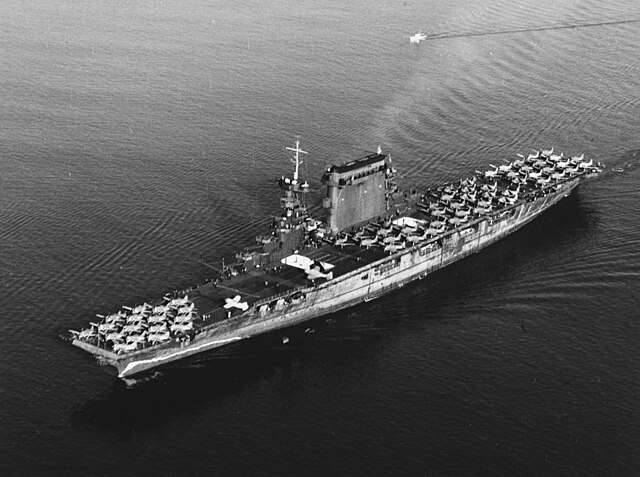
Her TF was later reinfirced by USS San Francisco and two destroyers on 10 February and she met the ANZAC Squadron on the 16th, but oil from Neosho was not enough for the Squadron to join the proposed raid on Rabaul. Brown’s force was reinforced by USS Pensacola and two destroyers on 17 February. 453 nautical miles northeast of Rabaul they were spotted by a Kawanishi H6K “Mavis” on 20 February and despite being short down by future ace and Commander Jimmy Thach and his wingman, the report came to the Japanese. They were cvaught again by another H6K confirming her position by Brown concluded her lost surprise and canceled the raid, now trying to lure Japanese aircraft on him.
Rear Admiral Eiji Gotō (24th Air Flotilla) took it and launched all 17 Mitsubishi G4M1 “Betty” torpedo bombers (4th Kōkūtai) equipped with 250-kilogram (550 lb) bombs. They were split into two groups but were caught by USS Lexington’s radar at 16:25. She soon launched her 15 fully fueled Wildcats and Dauntlesses to revover her CAP, just as she was caught by nine G4Ms, first wave, all missing and shot down afterward. She lost two Wildcats though. The second wave (eight) was spotted at 16:56 and intercepted by Lieutenant Edward O’Hare and wingman, Lt. Marion Dufilho, O’Hare shooting down three G4Ms, damaging two but they all missed the doging carrier at full speed. Only three G4Ms survived, so Brown made his points about a potentially risky tactic.
TF 11 later was refuelled by the tanker Platte on 22 February. One Japanese Aichi E13A “Jake” spotted them just after dark, but the six H6Ksfauled to locate them. TF 11 was refuelled and met the ANZAC Squadron on schedule, requested another permission for attacking Rabaul, however Nimitz ordered her to join USS Yorktown‘s Task Force 17 (RADM FJ Fletcher) north of New Caledonia on 6 March for a combined attack on Rabaul, from the south to avoiding Japanese search aircraft. On 8 March it was reported that Rabaul was empty and instead, the Japanese were at Lae and Salamaua so the plan was changed to a raid in the Gulf of Papua.
“York” aand “Sara” reached their positions on 10 March, Lexington launching first her CAP of eight Wildcats, then all 31 Dauntlesses and 13 Devastators, falling on 16 Japanese ships, sinking three transports, damaged others, then Yorktown’s strike 15 minutes later. She lost a Dauntless to AA fire while, claimed a Nakajima E8N floatplane. Despiote being spotted by one H6K, the 24th Air Flotilla never attacked deu to poor weather. TF 11 was ordered back to Pearl and obtained part of Yorktown’s air group as she was due to overhaul. They were back on 26 March.
After her short refit TF 11 passed under command of Rear Admiral Aubrey Fitch on 1 April. She was given the heavy cruisers Minneapolis and New Orleans, seven destroyers. They left on 15 April, Lex carrying 14 USMC Buffalos from VMF-211 for Palmyra Atoll. She later joined battleships of Task Force 1 off Christmas Island. On 18 April Allied codebreakers learned about Operation Mo (Attack on Port Moresby and Tulagi, SE southeastern Solomons) so she met with TF 17 (Yorktown) north of New Caledonia on 1 May, and was prepared for azction with on board 21 Wildcats, 37 Dauntlesses and 12 Devastators.
The end: Battle of the Coral Sea
TF 17 finished fuelling first and she sailed for the Solomon Islands on 2 May, TF 11 being ordered to met her and TF 44 (ANZAC Squadron) further west in the Coral Sea on 4 May for a pincer. Operation Mo succeeded as Tulagi fell on 3 May. Allied reconnaissance aircraft spotted shipping there so an air strike on Tulagi was confirmed. Meanwhile the Japanese multiplied reconnaissance flights without result.
One H6K spotted Yorktown still but was shot down by her CAP before reporting. USAAF aircraft meanwile spotted IJN Shōhō SW of Bougainville Island on 5 May but the US carriers were out of range. Fletcher was soon informed of three Japanese carriers near Bougainville Island so believed the attack was for 10 May, predicting airstrikes in support days before, depleting their air groups. He ordered to complete refueling on 6 May and sail to the eastern tip of New Guinea for a 7 May ambush.
Another H6K spotted the carriers on 6 May and reported, shadowing them, but air strikes were marred by poor weather. The next day, the Japanese were the first to spot the oiler Neosho and USS Sims at 07:22 south of the strike force. Misidentified they were targeted by amssive strikes from Shōkaku and Zuikaku 40 minutes later. Sims was sank, Neosho so badly damaged she later was scuttled. The American carriers were spotted by other Japanese aircraft with their own reconnaissance aircraft reporting two Japanese heavy cruisers NE of Misima Island (Louisiade Archipelago), eastern tip of New Guinea at 07:35. An airstrike was launched on the supposed Shōkaku and Zuikaku, 53 Dauntlesses and 22 Devastators plus 18 Wildcats. it was however a miscoded report. Another came out and the aircraft were diverted en route to IJN Shōhō and her main force, reported at 10:40. The IJN light carrier’s small CAP of two Mitsubishi A5M “Claude”, one A6M Zero was too small to block them.
Dauntlesses from VS-2 began attacked at 1110, none hit Shōhō, dodging all bombs. One Zero claimed a Dauntless, other Dauntlesses were damaged. Three more Zeros took off in between, and soon after Dauntlesses from VB-2 dove at 11:18, hit Shōhō twice with heavy AP bombs. They detonated in her hangar, packed with fuelling, armed aircraft. Next Devastators from VT-2 dropped torpedoes from both sides and hit Shōhō five times, she lost all power and later sunk. Lt. Cdr. Robert E. Dixon (VS-2) radioed the famous “Scratch one flat top!”
Meanwhile, Shōkaku and Zuikaku recovered aircraft and Rear Admiral Chūichi Hara (5th Carrier Division) ordered an air strike on the believed position of the American carriers, 12 Aichi D3A “Val”, 15 Nakajima B5N “Kate”, but it appeared they had mistaken TF 44 for Lexington and Yorktown. Lexington’s radar spotted nine B5Ns at 17:47 and she vectors both carriers CAPs, surprising them, and shooting down five, loosing one Wildcat. The six B5Ns low two, one badly damaged, one Wildcat lost. One D3A was aldo shot, and the sqn. leaders canceled the attack, ordered to jettison bombs and torpedoes. Radio direction finders were used to track their own carrier’s homing beacon, but it was broadcasted at a frequency very close to that the US, so many surviving Jap aircraft confused Lex and York in the darkness, even circling for attempting to land. They did not answered flashing signal lights, confused by remaining Wildcats attempting to land, until they were, and they were parly shot down. The remaining 18 IJN aircraft returned to their carriers from 20:00.
On the morning of 8 May the four carriers spotted each other at the same time, launched theior own strikes in a textbook carrier tactic at 09:00. The Japanese sent 18 Zeros, 33 D3As, 18 B5Ns. Yorktown launch first, Lexington seven minutes later in all 9 Wildcats, 15 Dauntlesses and 12 Devastators. Yorktown’s Dauntlessed hit Shōkaku twice, Lexington’s making another hit. The torpedo bombers failed and were shot down by an efficient and large Japanese CAP: 3 Wildcats, 2 Dauntlesses traded for 2 Zeros.
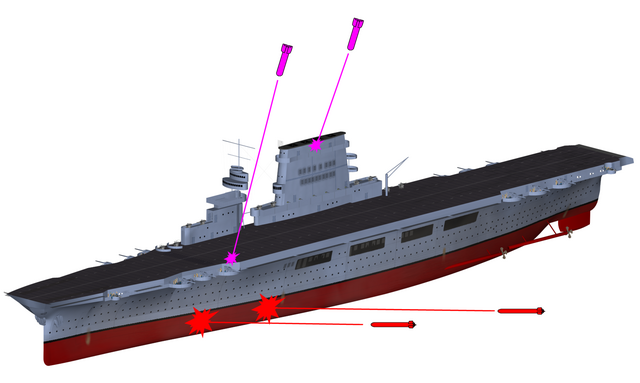
Confirmed direct hits sustained by Lexington during the battle
The Japanese airbone spotted the US carroers at 11:05, B5Ns attacking first as D3As started to circle around from upwind. Four B5N were shot down, no hit, but 10 survived and managed to hit Lexington twice, port side, 11:20, with 4 B5N more shot down by AA fire. War Correspondent Stanley Johnston aboard at the time on the signal bridge took famous photos during the battle and noted five torpedo hits, port side. The first at the bow jammed both elevators in up position, leaked the port avgas storage tanks. The second hit opposite to the bridge, breached the port water main, flooding three port fire rooms, boilers were shut down so Lexington fell to 24.5 knots with a 6–7° list to port.
Soon after, 19 D3As fell on her, one claimed by CAP, one by AA, but she She was hit by two bombs (port forward 5-in ready ammunition locker) and the funnel. Her siren was jammed in the “on” position and was heard for hours after. She had all the remainder making near-misses, but fragments peppered her hull and she had two compartments flooded. This was not critical, though.
Fuel was pumped out from port storage tanks to starboard to correct the list and the crews started to recover damaged aircraft on deck while others landed, low on fuel at 11:39. She had lost 3 Wildcats and 5 Dauntlesses, another crashing on landing. At 12:43 she launched a new CAP and prepared nine Dauntlesses when she was rocked by a massive explosion at 12:47 due to sparks igniting gasoline vapors from leaking port avgas tanks. 25 cwere killed, she losed her main damage control station. Flight deck operations carried on still but the refueling system was closed. Fueled Dauntlesses took off while 6 Wildcats landed. All were recovered by 14:14. One Devastator was forced to ditch also.
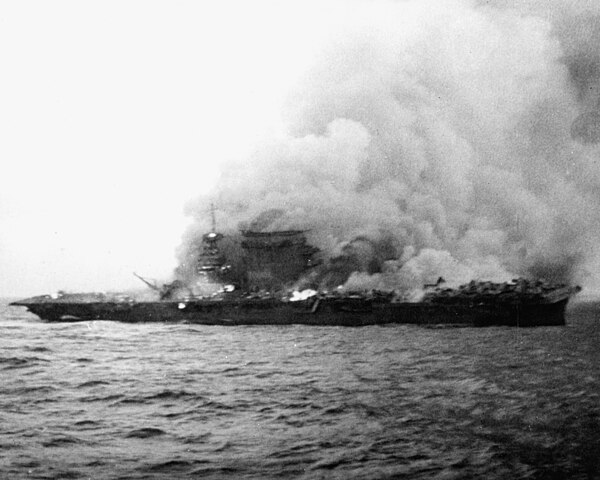
Lexington, abandoned and burning, several hours after being damaged by Japanese airstrikes
She had another large explosion at 14:42 with fire in her hangar, she lost her forward elevator, stuck 12 inches (305 mm) above the flight deck. The forward half los all power. Three destroyers were sent to assist ith their pimps until she was ravaged by another detonation at 15:25 and she lost water pressure in the hangar, as the forward machinery spaces. The fire spread and all compartments below the waterline were evacuated but at 16:00 she was stopped dead. The crew was ordered to abandon ship at 17:07. Large explosions rocked her from 18:00, destroying her aft elevator. The captain stayed on board until 18:30 as all crewmen were out before leaving. 2,770 officers and men survived. USS Phelps was ordered scuttle her with five torpedoes between and she finally sank past 20h00 PM, having 216 crewmen killed and loosing remaining 17 Dauntlesses, 13 F4F Wildcat fighters, 12 TBD Devastator, but the pilots and air crews survived.
Her wreck was located later on 4 March 2018 by Petrel (Paul Allen) and footage was taken by a ROV under 3,000 meters (9,800 ft), 500 mi east off Queensland on the seabed, broken into sections. For her short but intense campaign she won two battle stars, stricken on 24 June. One of the Essex-clas was renamed from Cabot to Lexington on 16 June 1942.
 USS Saratoga
USS Saratoga
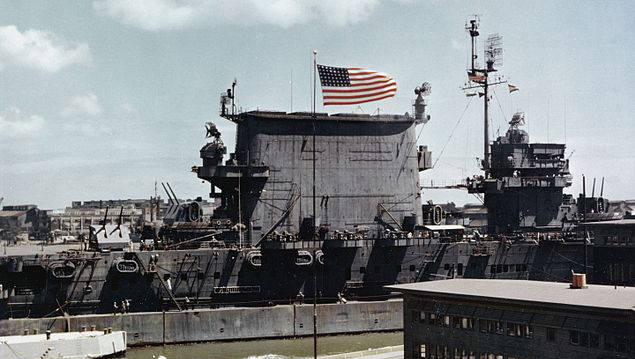
USS Saratoga at Pearl Harbor in 1945 – color photograph
USS Saratoga was commissioned one month earlier than her sister ship, and as she was visually identical her funnel received a large vertical black stripe for pilots when both operated together; Her shakedown cruise was on 6 January 1928 and she saw future admiral and pilot at that time Marc A. Mitscher landing the first aircraft. She refuelled the airship Los Angeles on 27 January. She crossed the Panama Canal but stopped at Corinto, Nicaragua, and arrived at San Pedro on 21 February. On 15 September under her new Captain John Halligan, Jr. she started local waters training until her first fleet exercise from January 1929, Fleet Problem IX, escorted by USS Omaha for a mock attack on the canal defended by her sister Lexington and she won. The next year however she was sunk by her sister and inverted this at Fleet Problem XI. She also took part in the Presidential Review at Norfolk and back to San Pedro.
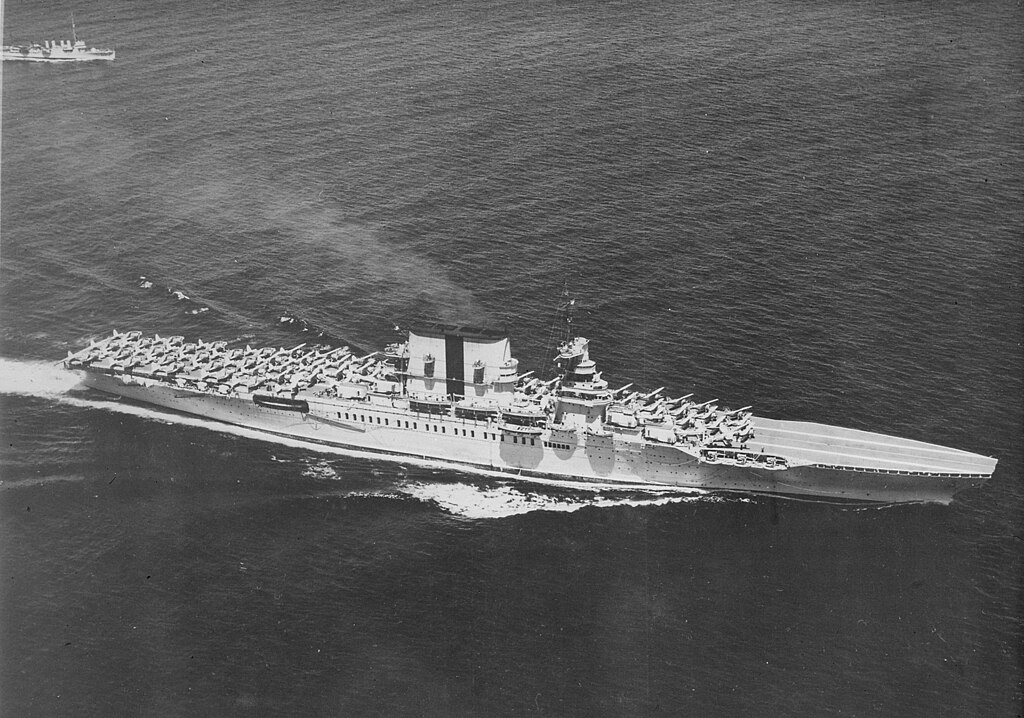
USS “Sara” off New York in 1934. The letters “SARA” were painted aft of the landing deck, in addition to her black band on the funnel to be sure not to be confused with her sister. Most sailors used to call here “Lady Sarah” when WW2 started. By 1945 whe unceremoniously executed in Bikini, she was indeed a proud but battered “grand old lady” with 17 years service and many battle stars.
Saratoga and Lexington teamed up in Fleet Problem XII in February 1931. In 1932 the movie “Hell Divers” was shoot aboard with Wallace Beery and Clark Gable at VF-1B. In Grand Joint Exercise No. 4, she proved an airstrike against Pearl Harbor, then she was at Fleet Problem XIII, Blue Fleet, attacking the West Coast against Lexington (Black Fleet). En route from San Diego to San Pedr she briefly ran aground off Sunset Beach on 17 August. Shee took part in a joint exercise with the army (Hawaii attack) and on Los Angeles and San Francisco. She hosted in 1933 Joe E. Brown’s comedy, “Son of a Sailor” and later took part in Fleet Problem XV before heading for the Caribbean in April–May 1934 and back at San Pedro by November. Captain William F. Halsey (yes, this one) assumed command on 6 July 1935 after Fleet Problem XVI. From 27 April to 6 June 1936, she was “sunk” while defending the Panama Canal Zone by opposing battleships and aircraft from Ranger. In Fleet Problem XVIII, 1937, under John H. Towers, covered an amphibious assault on Midway and nearly sunk by Ranger’s aircraft.
1938 Fleet Problem was on and around Hawaii, “destroyed” by Saratoga and sister on 29 March followed by San Francisco. Fleet Problem XX 1939 saw her staying on the West Coast, the center of Task Force 7, with the battleship Arizona and escorts under Rear Admiral Chester Nimitz in the Pacific. From 2 April to 21 June 1940 she took part in Fleet Problem XXI and with Lexington, “badly damaged” USS Yorktown.
From 6 January to 15 August 1941, she started a modernization at Bremerton and was the first with the CXAM-1 radar, being out by late November, with more AA and an FC radar.
On 7 December 1941, she was entering San Diego to receive her new air group, training ashore when she was in refit: 11 Grumman F4F-3 Wildcat (VF-3, Lt. Jimmy Thach), 43 Douglas SBD Dauntless (VB-3 and VS-3), 11 Douglas TBD Devastator (VT-3). She carried on deck 14 USMC Brewster F2A-3 Buffalo (VMF-221) for Oahu. She was the flagship of Carrier Division One (CarDiv 1) under Rear Admiral Aubrey Fitch. She left Pearl Harbor and was back on 15 December, refueled, departed for Wake, assigned to TF 14 (Rear Admiral FJ Fletcher) VF-3 receving two extra Wildcats from Hawaii, loosing one SBD ditching on 11 December.
She met with the oiler Neches and seaplane tender USS Tangier with reinforcements and supplies. She stopped to refuel her escorting destroyers on 21 December, delayed by heavy weather, and she arrived off Wak, but was recalled as the island fell on the 13th. When back she delivered VMF-221 to Midway on Xmas day. She was back on 29 December, Fletcher being replaced by Rear Admiral Herbert F. Leary, Fitch being transferred to a shore command. She was underway to Midway on 31 December.
When still 420 nautical miles SW of Pearl Harbor on 11 January 1942 she was signalled to meet USS Enterprise when torpedoed by I-6. Three of her boiler rooms were flooded and she fell to 16 knots, loosing six drown sailors. Her list was corrected by transferring fuel, and she reached Pearl Harbor for temporary repairs, seeing her main gun turrets removed and sent to defend Oahu. She sailed for Bremerton on 9 February for permanent repairs with 10 Wildcats of VF-2 and VS-3 as self-protection.
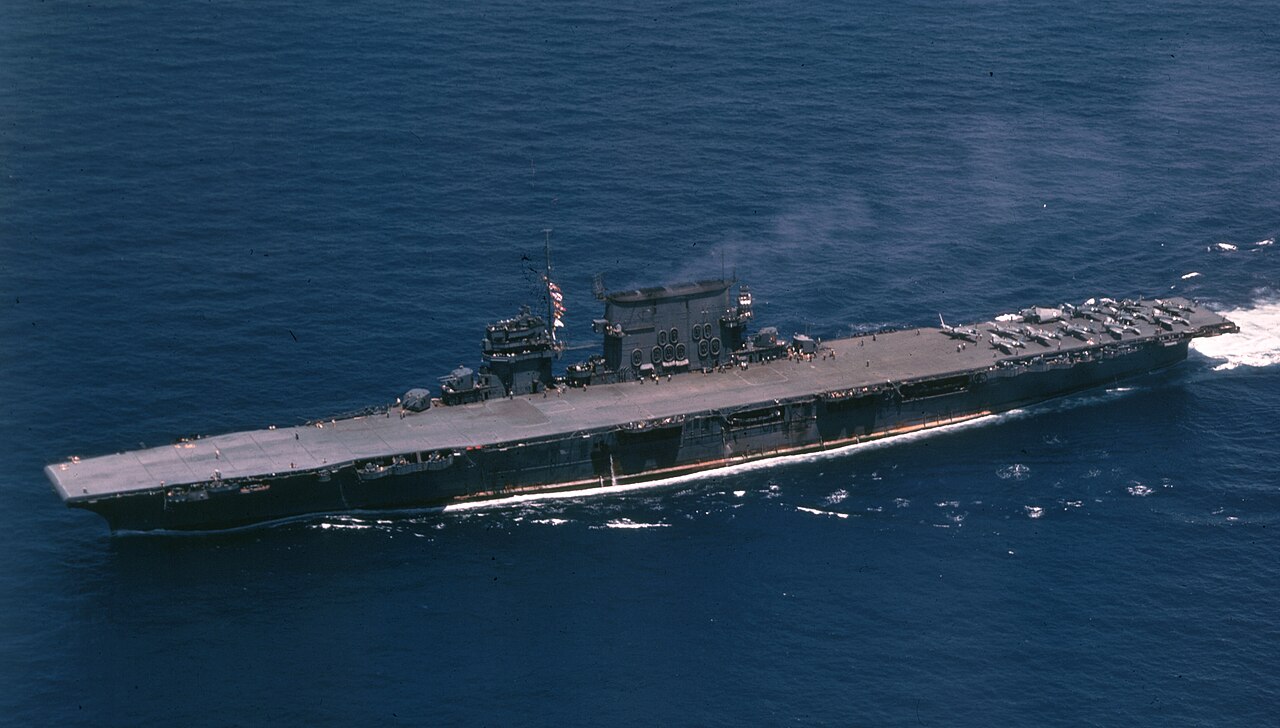
USS Saratoga post refit in 1942. Her marine blue livery was identical to her twin Lexington.
In Bremerton she was modernized, earning an anti-torpedo bulge, better AA and new radars. She departed on 22 May for San Diego, arrived the 25th, loaded aircraft and supplies while waiting for Admiral Fitch. On 30 May Nimitz as CiC Pacific Fleet, ordered Captain Ramsey to sail asap to Pearl Harbor, not waiting for Fitch, which she did on 1 June with 14 Wildcats (VF-2), 23 Dauntlesses (VS-3), 4 Wildcats, 43 Dauntlesses, 14 Avengers in cargo to be assembled and readied. She was in Pearl on 6 June, last day of the Battle of Midway. She refuelled and departed to ferry replacement aircraft for Enterprise and Hornet, with a grand total of 47 Wildcats, 45 Dauntlesses, 5 Devastators and 10 Avengers (comprising own air group). Fletcher was transferred from the lost Yorktown to her on 8 June as flagship. She met the Midway survivors on 11 June, transferred 19 Dauntlesses, 5 Devastators 10 Avengers and back to Pearl on 13 June where Fletcher disembarked, Admiral Fitch on board on 15 June (now “Sara” was in Task Force 11). 22-29 June saw her ferrying 18 USMC Dauntlesses (VMSB-231 ), 25 USAAF Curtiss P-40 Warhawks to Midway. Fletcher relieved Fitch on the 30th.
Guadalcanal Campaign:
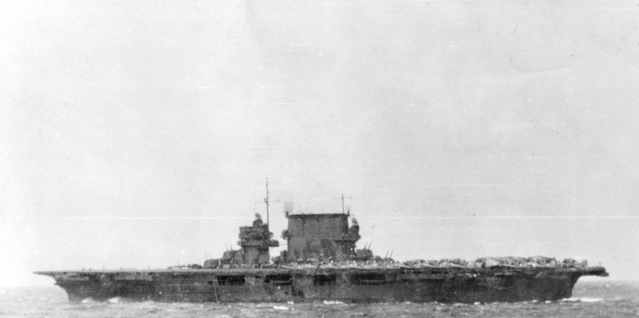
Saratoga operating off Guadalcanal
By late June 1942, she was prepared for the invasion of the southern Solomon Islands to secure routes between the the US, Australia, and New Zealand. Guadalcanal and Tulagi were intended as support bases to capture or neutralize Rabaul (New Britain), so Nimitz committed three of four carrier task forces, under Vice Admiral Robert L. Ghormley, South Pacific.
On 7 July, TF 11 (Sara) left Pearl accompanied by four heavy cruisers (USS Astoria, New Orleans, Minneapolis, Vincennes, all from the New Oerlans class) and seven destroyers plus three replenishment oilers, four fast transports (APDs from ww1 four pipers). She packed on board 90 aircraft: 37 Wildcats, 37 Dauntlesses, 16 Avengers. TF 18 (Wasp) met them south of Tongatapu on 24 July. TF 16 (Enterprise) was to start Operation Watchtower south of the Fiji Islands. The whole force of 61 vessels was under Task Force 61 (Fletcher). On 30 July, Saratoga covered the amphibious landings on Koro Island and trained for the newxt operations against Guadalcanal and Tulagi.
The force made it in the Solomon Islands undetected in thick fog and haze. Saratoga launched 24 Dauntlesses, 12 Wildcats on 7 August over Guadalcanal under Cdr. Harry D. Felt in cooperation with Wildcats from VF-6 (USS Enteprise). They attacked an airfield at Lunga and later it fell to the 1st Marine Division, renamed Henderson Field. Later they kept a CAP over the transports and provided close support to the Marines.
The Japanese launched 27 Mitsubishi G4M “Betty” escorted by 17 A6M Zero, including aces (Junichi Sasai, Toshio Ota, Hiroyoshi Nishizawa, and the best of bests, Saburō Sakai). They missed thecarriers and the bombers fell instead on the transports and escorts. There was only eight Wildcats from Saratoga’s VF-5. Five were down. One G4M was down. They still failed to hit any ships. One hour later, 9 Aichi D3A (“Val”) apparead, coming from Rabaul in a one-way mission and small bombs, expected to ditch at Shortland Island when back, close to a Japanese seaplane tender, but they were greeted by a CAP of 15 Wildcats from VF-5 and VF-6. They attacked two of the escorting destroyers, lightly damaged one, loosing themselves five.
Saratoga had declining fuel reserves and aircraft, loosing 20% of her fighters. Fletcher was asked for by Ghormley to withdraw to refuel on 9 August. They could not thus, reach the Japanese cruiser force which surprised and sank four Allied cruisers of her own escort that night. The transports were ignored entirely. Fletcher rendezvoused with the aircraft transport Long Island on 19 August and covered the transports to Guadalcanal launching USMC aircraft for Henderson Field.
Battle of the Eastern Solomons:

USS Saratoga CV-3 off Guadalcanal 1942
On 24 August, the japanese launched the first of many reinforcement plans to Guadalcanal and aimed at finding Fletcher’s carrier they knew were asomewhere. Shōkaku and Zuikaku and Ryūjō constituted their best asset. Japanese troop transports were spotted on 23 August, 300 nautical miles north of Guadalcanal. When two transports were spotted at Faisi, Fletcher ordered Saratoga to launch an airstrike of 31 Dauntlesses, six Avengers at very long range. Poor visibility and also the fact they reversed course after being spotted saw the strike fail. At this extreme range, they landed at Henderson Field, intended to refuel and fly to Saratoga the next morning.
VADM Chūichi Nagumo (1st Carrier Division) ordered Ryūjō, Tone and two destroyers to attack Henderson Field under Yamamoto’s orders. Ryūjō was located next morning but was not attacked. Fletcher’s reconnaissance aircraft failed to located indeed the other Japanese carriers. Ryūjō launched an airstrike against Henderson Field, making little damage and loosing 7 of 21 aircraft.
Saratoga launched an airstrike against Ryūjō in the afternoon: 31 Dauntlesses, 8 Avengers, no fighter escort. Meanwhile reconnaissance aircraft from Enterprise spotted the Japanese formation. Saratoga’s aircraft sighted Ryūjō, hit thrice with bombs and one torpedo and she capsized 4 hours later.
One hour after Saratoga had her airstrike launched, the Japanese did the same after locating the American carriers. Shōkaku+Zuikaku sent 27 D3As and 12 Zeros. Meawnhile SBDs from Enterprise spotted the 1st Carrier Division and were all but one short fown by Zeroes of the CAP. The report was garbled and not understood however, but Nagumo launched a second airstrike of 27 D3As and 9 Zeros.
The first airstrike found TF 16 defended by VF-6, warned by radar and all available fighters took off. Despite of this, USS Enterprise was nearly sunk with three bomb hits, for 19 dive bombers and 4 Zeros lost. 5 Wildcats were down. In all, 52 Japanese aircraft were claimed and the second airstrike failed to locate the carriers.
Saratoga cleared her deck and launched 2 Dauntlesses and 5 Avengers, which found and damaged the seaplane tender IJN Chitose (not yet converted at the time) by near misses, shooting down 3 Mitsubishi F1M sent in defence. 2 Avengers made emergency landings, claimed one Zero from Shōkaku. Two US carriers recovered aircraft and withdrew, Enterprise sailing for repairs in Tongatapu, leaving Saratoga to refuel and receiving CV-6’s 17 Wildcats and 6 Avengers.
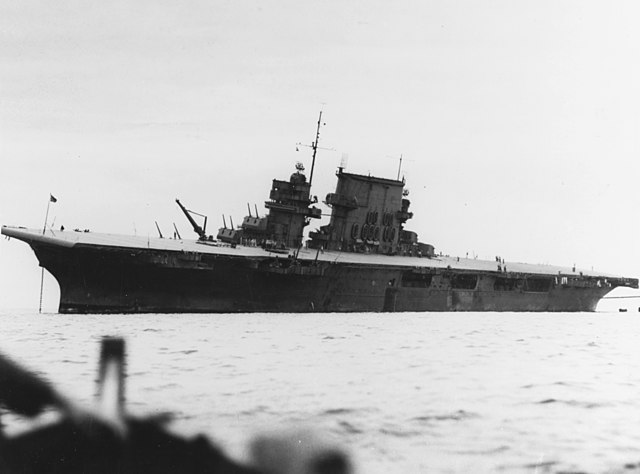
Saratoga under repair at Tongatapu after being torpedoed by I-26, September 1942
Fletcher met TF 18 off San Cristobal on 26 August, transferred 4 Wildcats to Wasp. TF 17 (Hornet) arrived on 29 August. But on 28 August while underway, USS Sratoga was torpedoed (one hit) by I-26. Her starboard side aft of the island was blasted and flooding commenced (one fire room, 4° list), wounding 12 sailors including Fletcher. She had also short circuits and fire started. Her turbo-electric propulsion failed so she ended dead in the water until repairs, covered by USS Minneapolis which tried to tow her, while she launched her aircraft for Espiritu Santo, keeping 36 fighters. At noon all her issues had been corrected and she could steam to Tongatapu on 6 September. She sent 27 Wildcats for Efate and received temporary repairs before leaving for Pearl on 12 September, escorted by USS South Dakota, New Orleans and five destroyers, arriving on 21 September, entering drydock for permanent repairs.
TF 11 under Rear Admiral Ramsey sailed for Nouméa (New Caledonia) via Viti Levu, and Fiji with New Orleans, the fleet oiler Kankakee, six destroyers. She carried VF-6, VB-3 and VS-6, VT-3. New Oerland was replaced by USS San Juan on 29 November and she made it in Nouméa on 1 December. One of her main turbines was repaired until 13 December.
On 23 January 1943, she launched 18 Wildcats from VF-3, 24 Dauntlesses from VB-3/VS-3, 17 Avengers from VT-3 to Henderson Field, keeping 16 Wildcats, 15 Dauntlesses. They still attacked the airfield at Vila (Solomons) after a light cruisers shelling. They all went back to the carrier without loss.
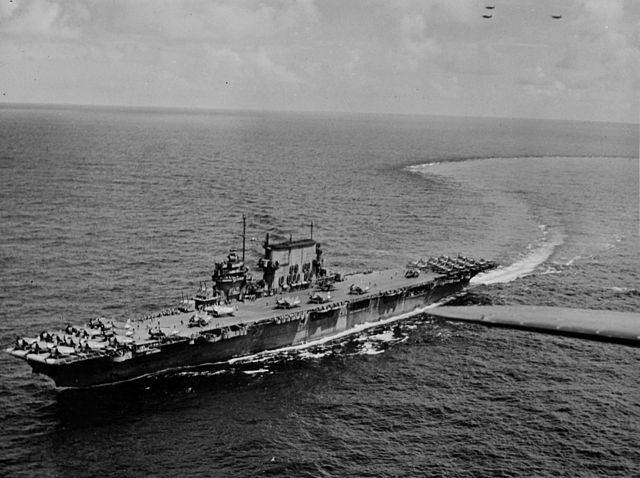
Saratoga in 1943
After USS Enterprise left just as Wasp, and Hornet, Yorktown, and Lexington in the bottom, the Pacific fleet was hanging by the fingernails to the now battered USS Saratoga alone in the South Pacific. TF 14 was reinforced by HMS Victorious on 17 May. Whe ready for next operations she had Enteprise’s 34 Wildcats (VF-5) plus her own 37 Dauntlesses (VB-3, VS-3) 16 Avengers (VT-3) and Ramsey was to provide distant cover for the landings on New Georgia. Victorious could not operate the Avengers from 832 Squadron so they were exchanged for 24 Wildcats from VF-3. However the British carrier also had better comand and control facilities. Sara retained 12 Wildcats for self-defense. The Japanese carriers left the American transports safe and Ramsey was replace on 26 July by Rear Admiral Frederick C. Sherman. Victorious left on 31 July for home. 11 Avengers were kept as reserves for Saratoga.
Bougainville campaign
Carrier Air Group (CAG) 12 was assigned to Saratoga instead of CAG 3, arriving aboard on 1 August with VF-12, VB-12 and VT-12, 36 each fighters and bombers and 17 torpedo bomber. For the first timle she operated the brand new Grumman F6F Hellcat. Her unit was renamed Task Force 38 (yes the future mighty TF 38/58) on 4 August. She was based at Havannah Harbor, Efate, Espiritu Santo until November 1943. While refueling at sea on 12-13 October she collided with her oiler Atascosa. On 22 October one of the first Independence class arrived to escort her, USS Princeton. She was there to provide a large CAP.
On 27 October, TF 38 covered the invasion of the Treasury Islands, before the invasion of Bougainville. On 1 November, her airstrikes destroyed Japanese airfields in the north and at Buka Island. 15 aircraft were destroyed for the loss of 3 Hellcats, 1 Dauntless, 2 Avengers. When refuelling she leaned on 3–4 November that Japanese cruisers were massing at Rabaul. Admiral Halsey ordered TF 38 to strike before they could engage transports for Bougainville: 23 Avengers, 22 Dauntlesses, and all fighter on 5 November, even from Princeton. Her CAP was provided by those from New Georgia. Surprise was achieved, 4 heavy cruisers, 2 light cruisers, 1 destroyer were badly damaged. 9 aircraft were lost.
Saratoga and Princeton then attacked Rabaul on 11 November, this time with the three escort carriers from Task Group 50.3. TF 38 then returned to Espiritu Santo (14 November). She was integrated into Task Group 50.4 as Relief Carrier Group for the Gilbert Islands Campaing. They stroke Nauru on 19 November. When withdrawing they were unsuccessfully attacked by 8 G4Ms, half downed. Saratoga transferred aircraft to replace losses on the other carriers and sailed for Pearl Harbor on 30 November, arrived on 4 December, off-loaded her aircraft and stores and sailed to San Francisco (9 December) for her last major refit.
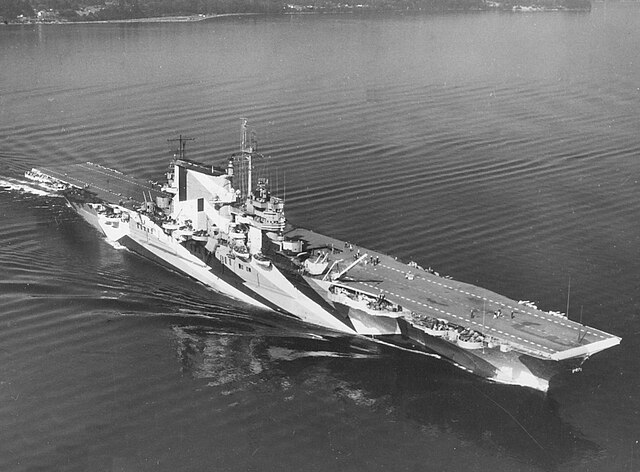
USS Saratoga after her refit in September 1944, off Puget Sound.
Saratoga had her refit complete by 2 January 1944 and she was at Pearl Harbor on 7 January as flagship of Rear Admiral Samuel Ginder, TG 58.4. She sailed out with the new USS Langley (CVL) and Princeton for the invasion of the Marshall Islands on 1 February. She carried 36 Hellcats (VF-12) 24 Dauntlesses (VB-12 – note the troublesome Helldiver was not assigned yet) and eight Avengers (VT-8). She attacked airfields at Wotje and Taroa (29–31 January) and installations at Rongelap and Utirik Atoll (1 February), then Engebi, Eniwetok Atoll (3-6 February) refuelled, and launched new airstrikes at Eniwetok (10-12 February). She covrred the Marines in the Battle of Eniwetok on 17-24 February and protected Allied forces until 28 February.
Sara’s Indian Ocean Campaign
On 4 March, Saratoga she refuelled and left Majuro with three destroyers for the British-led Eastern Fleet in the Indian Ocean. She met them on 27 March and arrived at Trincomalee, on 31 March. After weeks of intensive training with HMS Illustrious for an attack on Sabang (Operation Cockpit) on 19 April. She had at the time mobilized 27 Hellcats, 24 Dauntlesses, 18 Avengers, launched 24 Hellcats, 11 Avengers, 18 Dauntlesses and Illustrious 17 Fairey Barracuda, 13 Vought F4U Corsair fighters. Total surprise was achieve, the airfield wrecked and 24 aircraft destroyed, as the port facilities and oil storage tanks, one freighter sunk. One Hellcat was lost to AA. The Japanese launched 3 G4Ms, all shot down by their CAP. On 6 May they left Ceylon again to strike the oil refinery at Surabaya (Java) on 17 May after a refuelling in Australia. The refinery was mostly uncvaed, by a small ship was sunk. One Avengers never returned. Saratoga was relieved and ordered back to Pearl Harbor, arrived on 10 June.
Next she sailed to Bremerton for her very last overhaul over several months. It was completed with sea trials on 13 September. She was sent to NAS Alameda on 16 September to load 85 aircraft as well as 1500 passengers and cargo for Pearl Harbor, leaving San Francisco and arrived on 24 September. There, she was assigned CarDiv 11 and started to train night fighter pilots with night tactics and doctrine following British experience. Rear Admiral Matthias Gardner struck his mark on Lady Sara on 10 October. She was later accidentally rammed by the DD USS Clark and her port side needed repairs so Operations were cancelled. After a new brief refit in November and Carrier qualification until January 1945 she was declared ready for the last operations of her career, and still tough assignments.
Battle of Iwo Jima
On 29 January she left Pearl for Ulithi, meeting another revenant, USS Enterprise. There, they form the night fighter task group TG 58.5 (Night Carrier Division 7) to cover by night the amphibious landings on Iwo Jima. She arrived on 8 February with 53 Hellcats, 17 Avengers. She made diversionary strikes on the Japanese home islands (16-17 February) and provided fighter cover during TF-58’s Essexes class strikes on Japan. Still, without oposition, her fighters raided two Japanese airfields. After refuelling on 18-19 February, she provided aor cover above Iwo Jima on 19–20 February. She was detached with three destroyers to the amphibious force and started night patrols over Iwo and Chichi Jima.
However under low cloud cover, six Japanese aicraft went through and made five bomb hits on Saratoga in three minutes and being kamikazes, three hit her as well. Her flight deck forward was completely wrecked and her starboard side holed with large fires in her hangar, 123 dead or missing, 192 wounded plus 40 aircraft destroyed (31 F6F Hellcat, 9 TBM Avenger). Another attack two hours later caused another hit on her flight deck. Still one hour later, all fires were under control and her deck aft repaired so she can recover six fighters. At that stage, there was no other options but repairs at Bremerton. She arrived on 16 March.
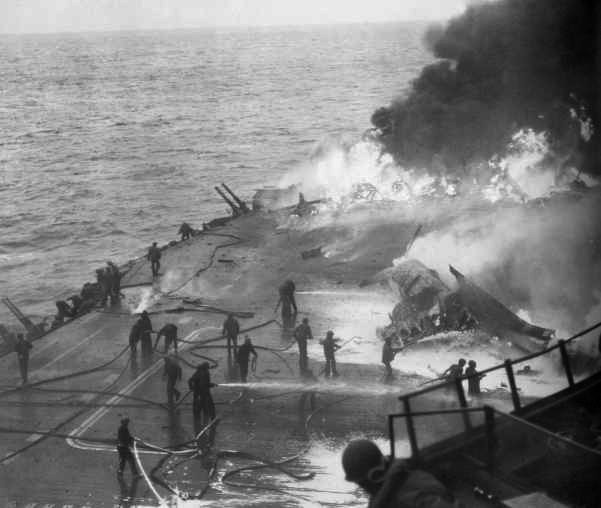
Saratoga after having been hit by a kamikaze, 21 February 1945
As Training Carrier (Summer 1945)
Due to her age and the flurry of new modern Essex class fleet carriers in service it was decided more judicious to modify her as training carrier:
-Her aft elevator was removed, opening plated over
-Her forward elevator was replaced by a larger, sturdier and faster one.
-Part of her hangar deck was converted into classrooms.
Post-refit trials on 12 May showed issue with one turbine, while a worn out 5-inch gun exploded, wounded 11. After 20 May she sailed to NAS Alameda to pickup 60 aircraft, 1,200 passengers and trucks for Pearl, arrived on 1 June as flagship, Rear Admiral Ralph F. Jennings (Carrier Division 11). From then on she started a long, unglamorous but important serie of carrier qualification training from 3 June 1945. In dockyard on 10 June she had a new 5-in gun mount installed and Jennings was transferred to another carrier. She went on training carrier pilots after the Japanese surrender, and until 6 September.
Magic Carpet and Bikini test
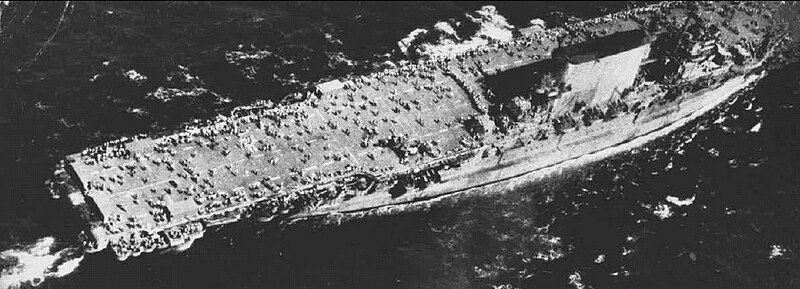
Saratoga during an Operation Magic Carpet voyage in 1945
After a 17-year career, 98,549 landing, the then absolute world record, and eight battle stars for her service she was still needed. This time for a peaceful task, Operation Magic Carpet, repatriatiing US servicemen from all theaters. She left Hawaii on 9 September with 3,712 personal for the United States. In other runs she carried 29,204 veterans, more than any USN ship that took part in the operation.
When over, the battered grand old lady was surplus to postwar requirements and was assigned to Operation Crossroads on 22 January 1946.
She sailed for a test conducted at Bikini Atoll to study an atomic bomb blmast effect on ships. Captain Stanhope Ring was to be her last commmander, taking board on 6 March, but he relieved on 2 June by Captain Donald MacMahan. Onboard was comedian Jack Benny which broadcasted his radio show on 21 April while berthed in San Francisco and prepared with loads of sensors and marking for Bikini. She left pier 33 for her last voyage, passed the Golden Gate on 1 May 1946 and sailed out in the shining sea for a tiny attoll in the middle of the great blue.
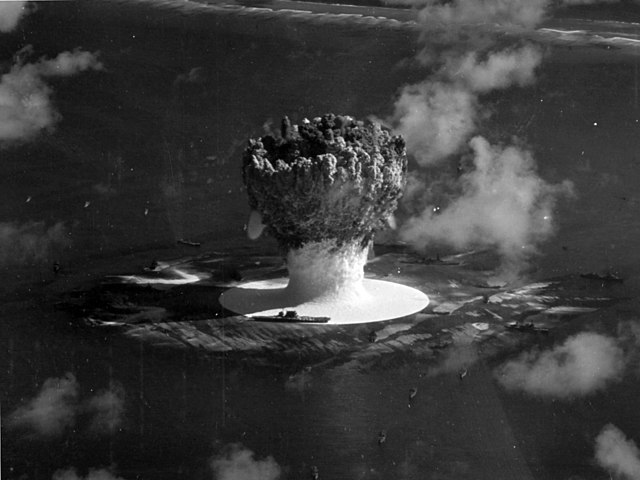
Operation Crossroads saw her posted “near” the detonation point of Test Able but not to close. There was an air burst on 1 July 1946 and she survived the explosion with minor damage, her teak deck however burned almost entirely to a crisp. There was still a skeleton crew aboard a day after to gather data and prepare her for the next test on 25 July. Test Baker saw her this time much closer to the detonation point at 400 yards (370 m), which was underwater. This time, the massive hull was literraly lifted out of the water, and she crushed into the sea, wrecking her entire flight deck and her massive funnel collapsed onto it. It was like a giant hand had played with her. Baldy damaged and severly irradiated she was struck on 15 August 1946.
The submerged wreck is still there today. Her tallest point is just 50 ft (15 m) below the surface. Now that radiation levels are low enough, she is a popular scuba diving destination, populated again by miryads of fishes and marine life.
Read More/Src
Books
Links
globalsecurity.org
archive.org steppingstonesto00gale
ww2/us/aircraft-carriers
navypedia.org/
en.wikipedia.org/
archive.org/ original plans for free More printed by battlemaps.us
on researcheratlarge.com/ CV2 Plans
Videos
Model Kits
modelwarships.com
On scalemates
3D
First Published on Apr 14, 2016.


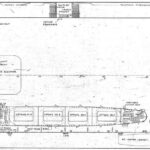
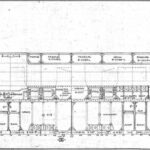
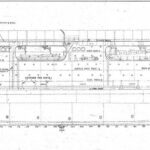

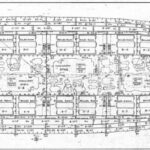
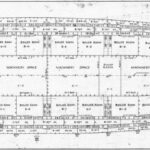
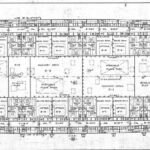
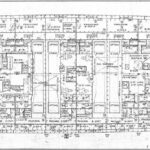
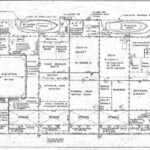
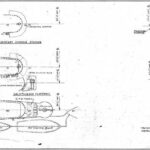
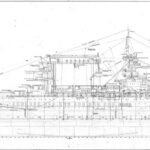
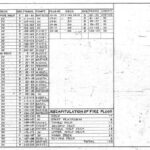
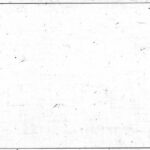
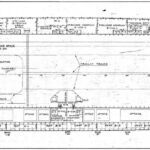
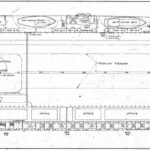
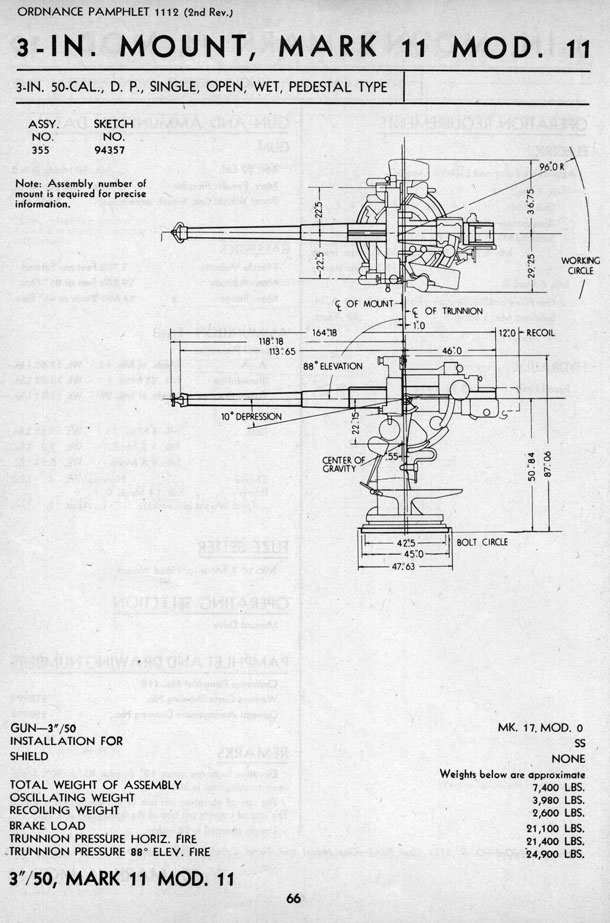
 Latest Facebook Entry -
Latest Facebook Entry -  X(Tweeter) Naval Encyclopedia's deck archive
X(Tweeter) Naval Encyclopedia's deck archive Instagram (@navalencyc)
Instagram (@navalencyc)





 French Navy
French Navy Royal Navy
Royal Navy Russian Navy
Russian Navy Armada Espanola
Armada Espanola Austrian Navy
Austrian Navy K.u.K. Kriegsmarine
K.u.K. Kriegsmarine Dansk Marine
Dansk Marine Nautiko Hellenon
Nautiko Hellenon Koninklije Marine 1870
Koninklije Marine 1870 Marinha do Brasil
Marinha do Brasil Osmanlı Donanması
Osmanlı Donanması Marina Do Peru
Marina Do Peru Marinha do Portugal
Marinha do Portugal Regia Marina 1870
Regia Marina 1870 Nihhon Kaigun 1870
Nihhon Kaigun 1870 Preußische Marine 1870
Preußische Marine 1870 Russkiy Flot 1870
Russkiy Flot 1870 Svenska marinen
Svenska marinen Søværnet
Søværnet Union Navy
Union Navy Confederate Navy
Confederate Navy Armada de Argentina
Armada de Argentina Imperial Chinese Navy
Imperial Chinese Navy Marinha do Portugal
Marinha do Portugal Mexico
Mexico Kaiserliche Marine
Kaiserliche Marine 1898 US Navy
1898 US Navy Sovietskiy Flot
Sovietskiy Flot Royal Canadian Navy
Royal Canadian Navy Royal Australian Navy
Royal Australian Navy RNZN Fleet
RNZN Fleet Chinese Navy 1937
Chinese Navy 1937 Kriegsmarine
Kriegsmarine Chilean Navy
Chilean Navy Danish Navy
Danish Navy Finnish Navy
Finnish Navy Hellenic Navy
Hellenic Navy Polish Navy
Polish Navy Romanian Navy
Romanian Navy Turkish Navy
Turkish Navy Royal Yugoslav Navy
Royal Yugoslav Navy Royal Thai Navy
Royal Thai Navy Minor Navies
Minor Navies Albania
Albania Austria
Austria Belgium
Belgium Columbia
Columbia Costa Rica
Costa Rica Cuba
Cuba Czechoslovakia
Czechoslovakia Dominican Republic
Dominican Republic Haiti
Haiti Hungary
Hungary Honduras
Honduras Estonia
Estonia Iceland
Iceland Eire
Eire Equador
Equador Iran
Iran Iraq
Iraq Latvia
Latvia Liberia
Liberia Lithuania
Lithuania Mandchukuo
Mandchukuo Morocco
Morocco Nicaragua
Nicaragua Persia
Persia San Salvador
San Salvador Sarawak
Sarawak Uruguay
Uruguay Venezuela
Venezuela Zanzibar
Zanzibar Warsaw Pact Navies
Warsaw Pact Navies Bulgaria
Bulgaria Hungary
Hungary

 Bundesmarine
Bundesmarine Dutch Navy
Dutch Navy Hellenic Navy
Hellenic Navy Marina Militare
Marina Militare Yugoslav Navy
Yugoslav Navy Chinese Navy
Chinese Navy Indian Navy
Indian Navy Indonesian Navy
Indonesian Navy JMSDF
JMSDF North Korean Navy
North Korean Navy Pakistani Navy
Pakistani Navy Philippines Navy
Philippines Navy ROKN
ROKN Rep. of Singapore Navy
Rep. of Singapore Navy Taiwanese Navy
Taiwanese Navy IDF Navy
IDF Navy Saudi Navy
Saudi Navy Royal New Zealand Navy
Royal New Zealand Navy Egyptian Navy
Egyptian Navy South African Navy
South African Navy






























 Ukrainian Navy
Ukrainian Navy dbodesign
dbodesign